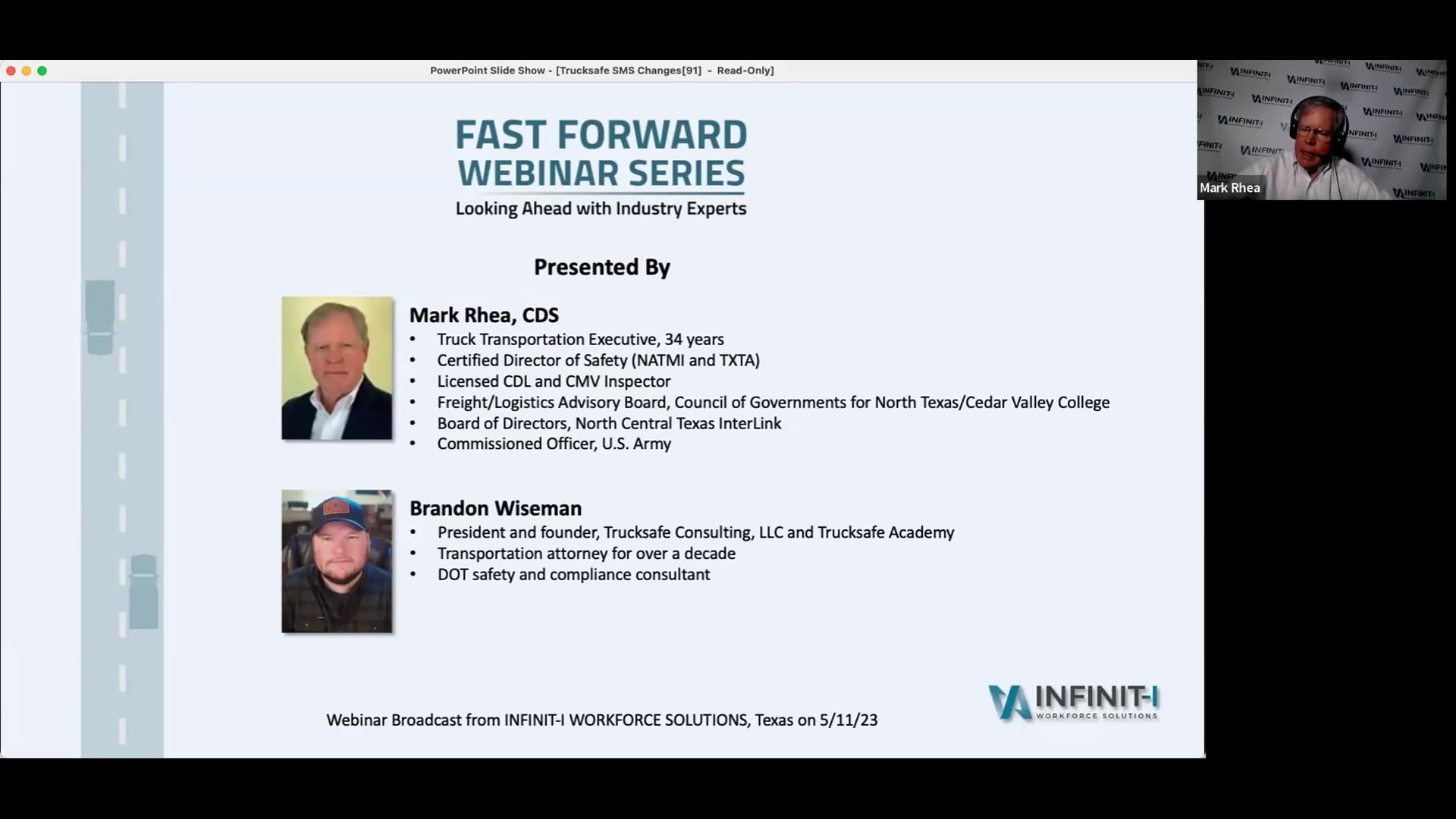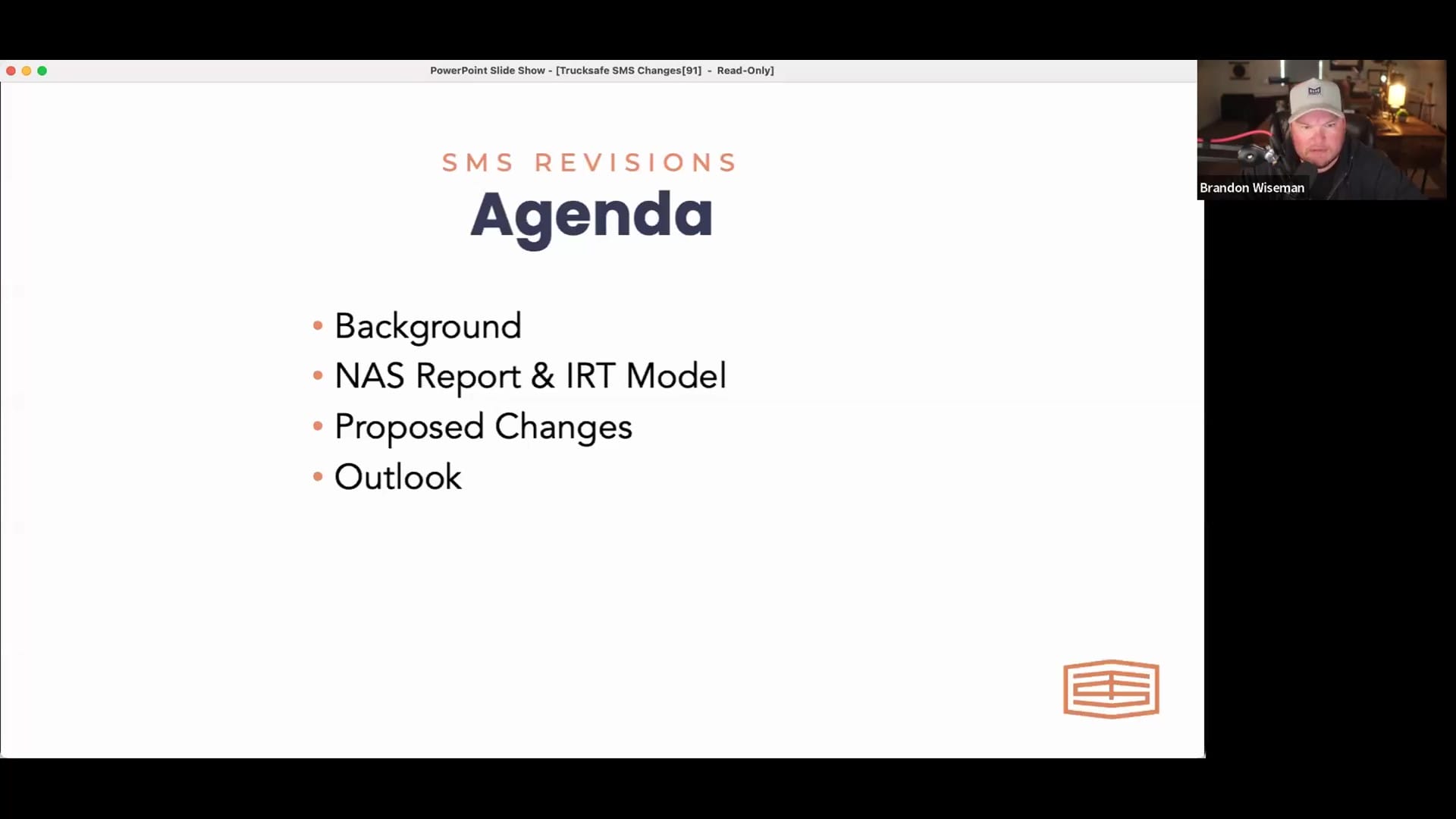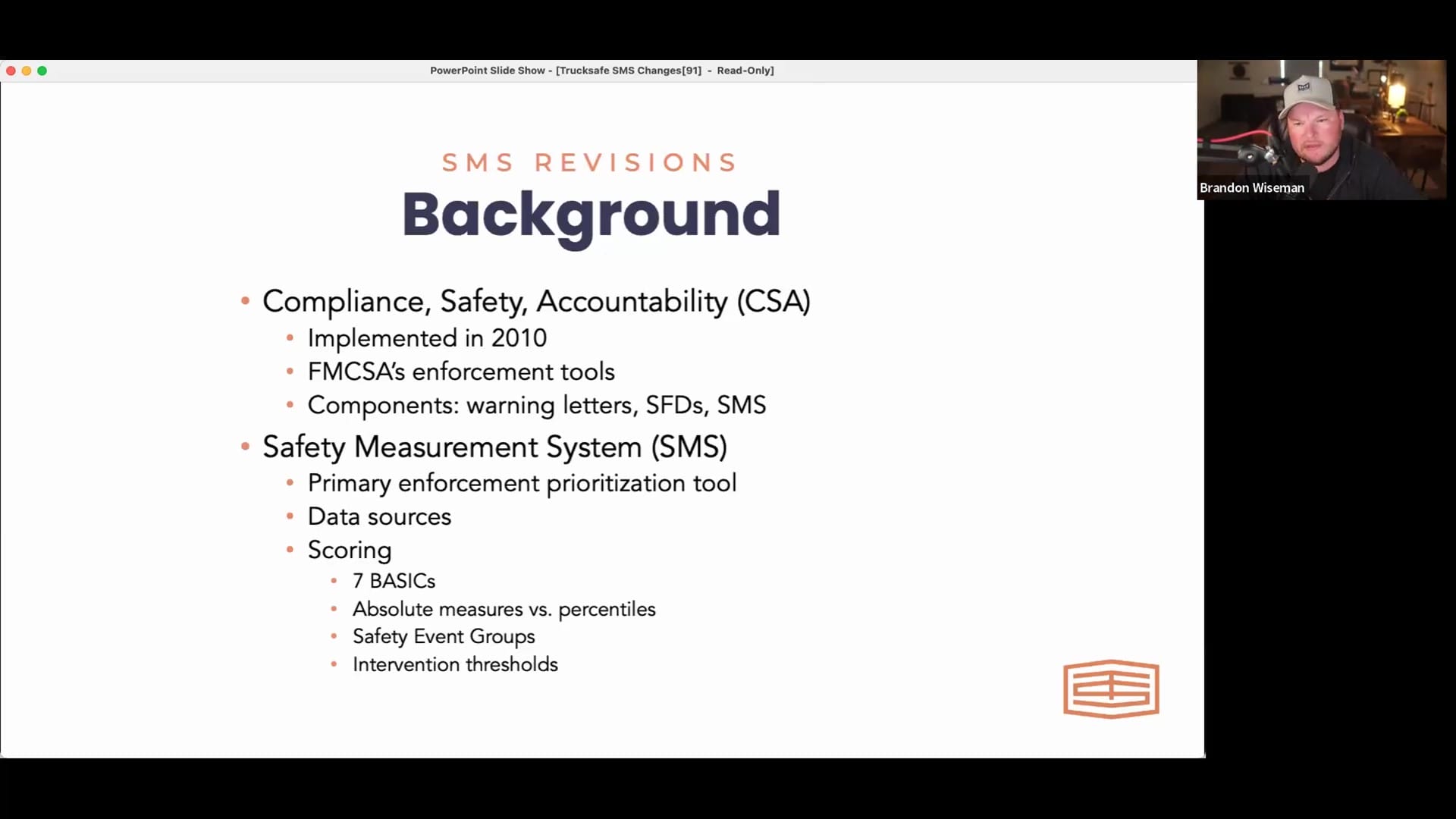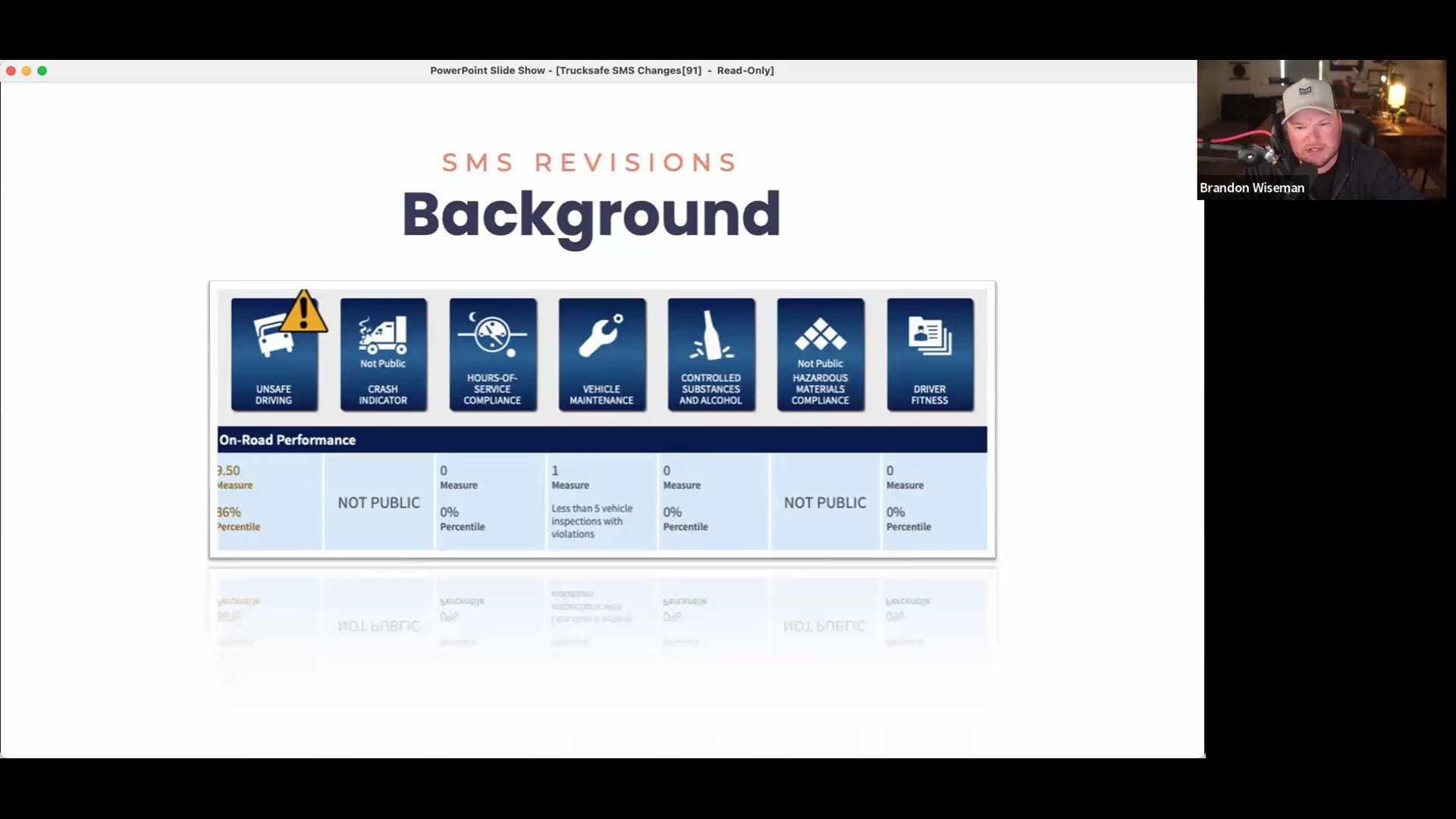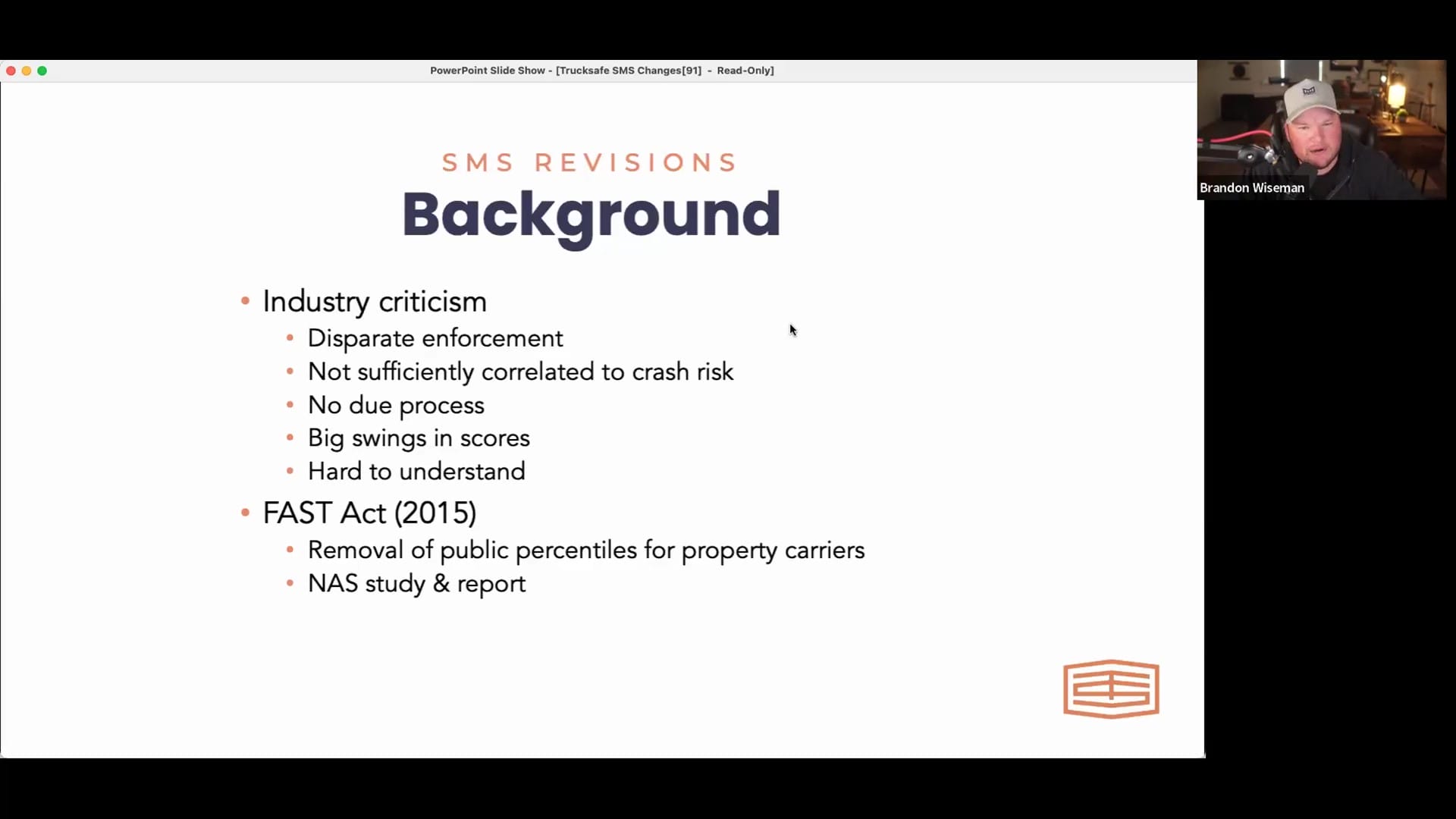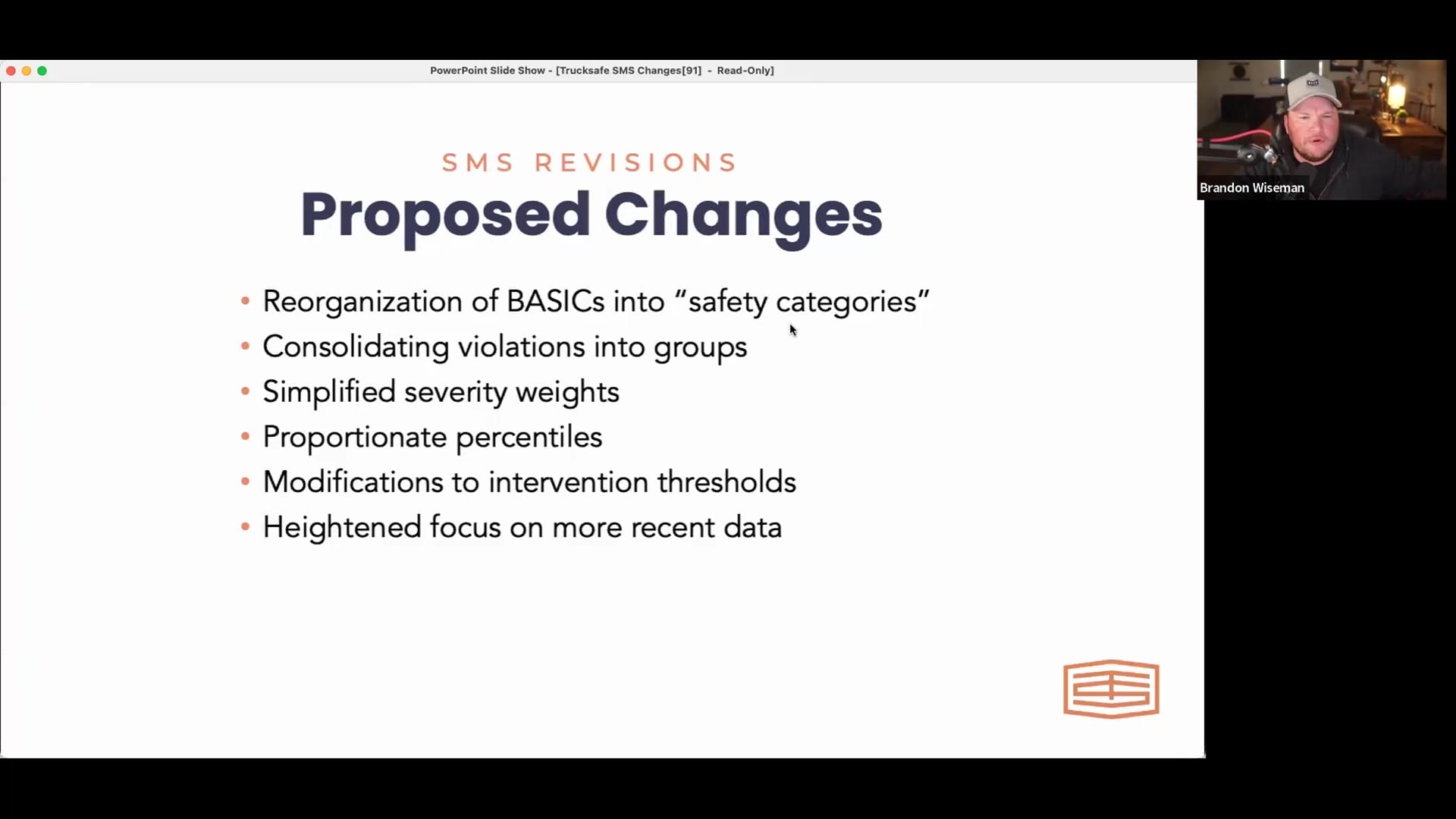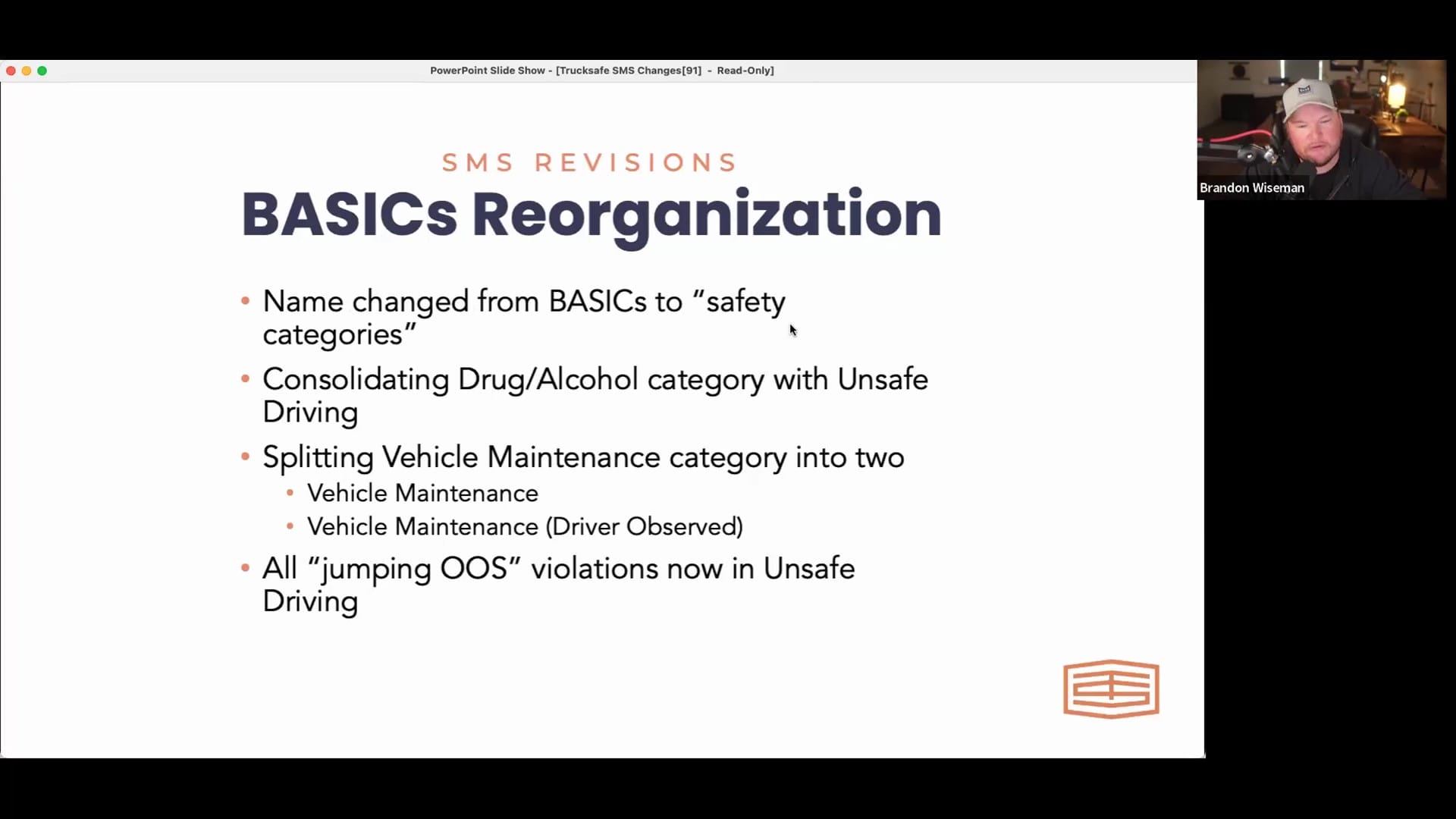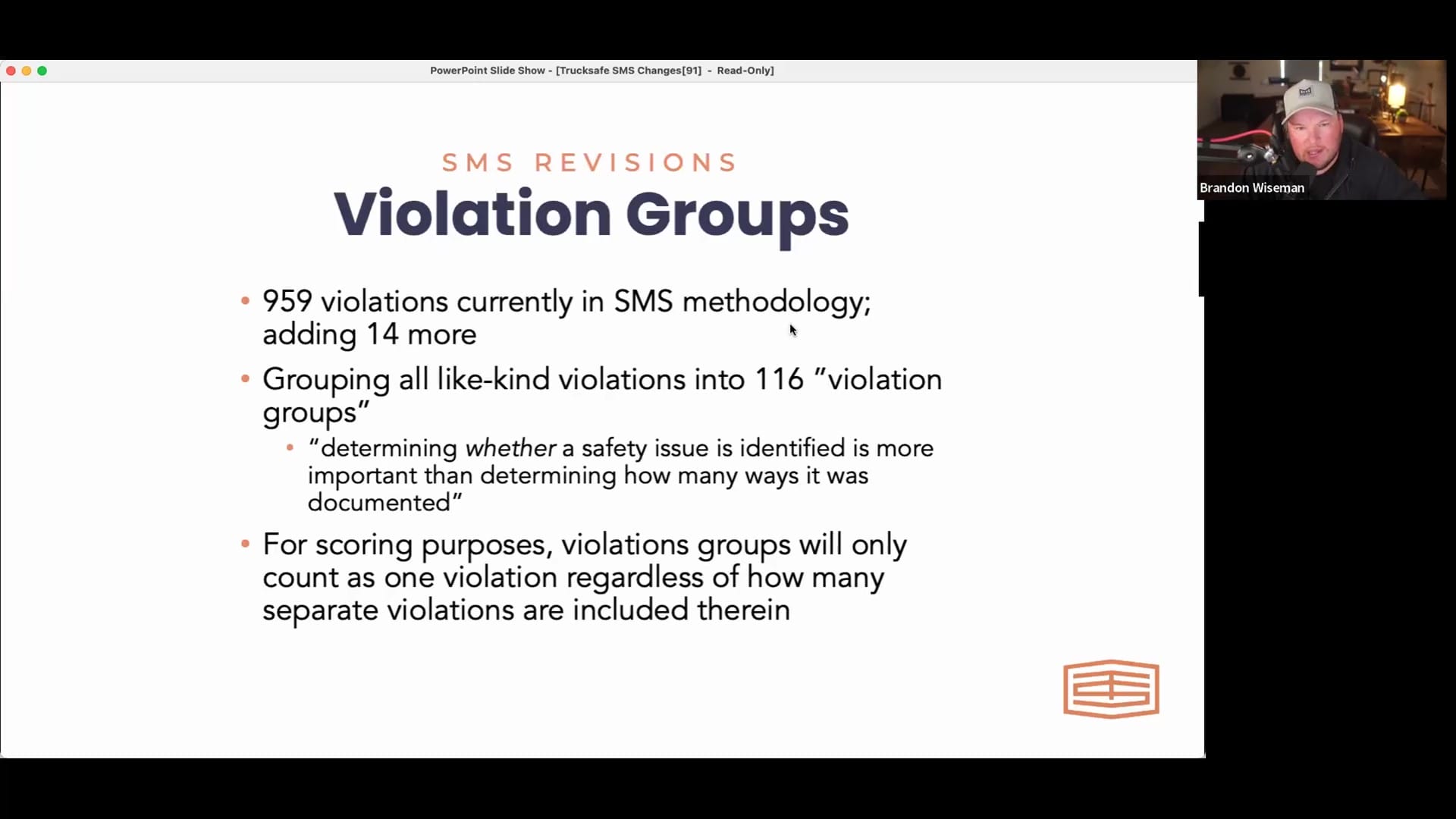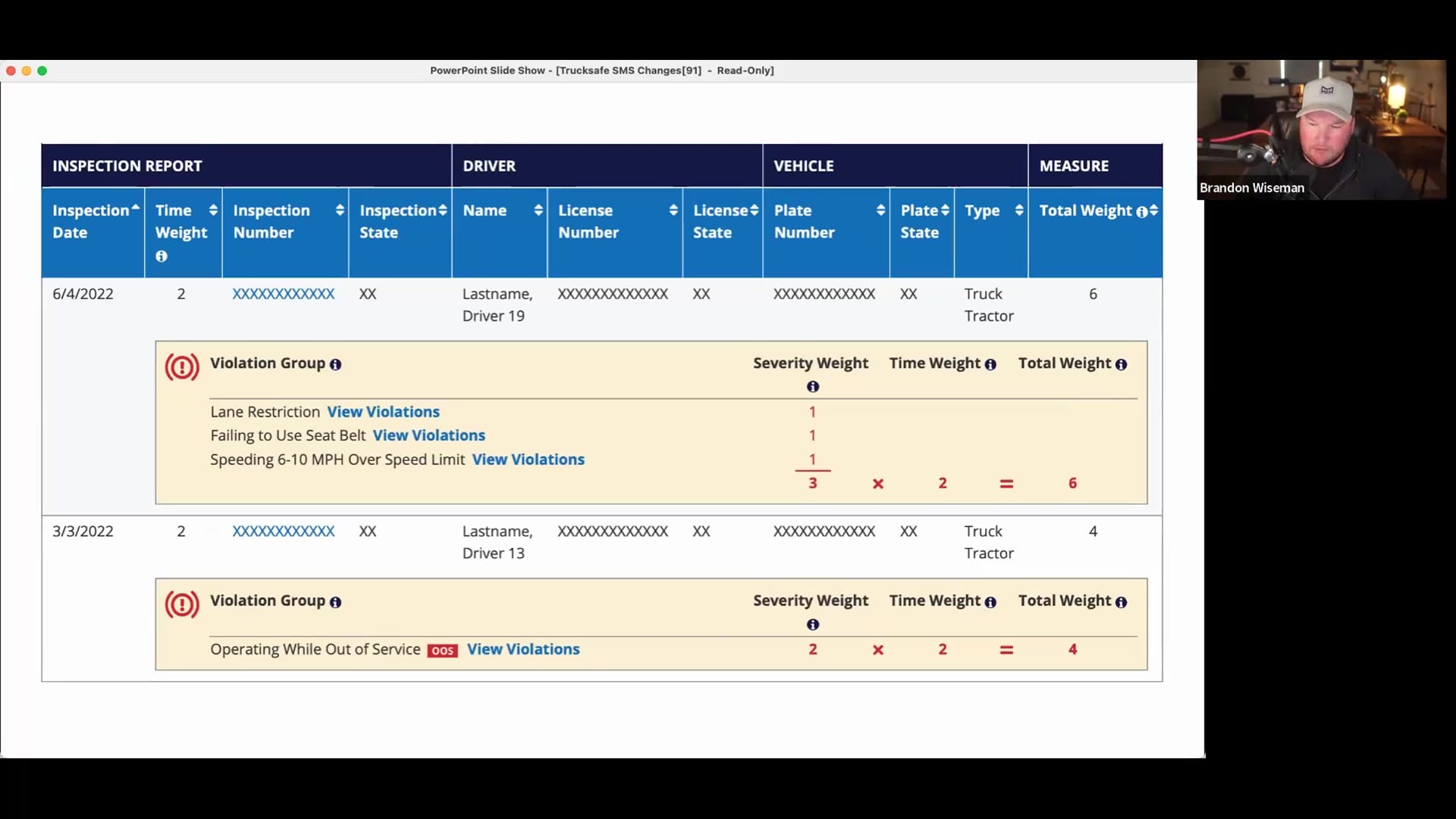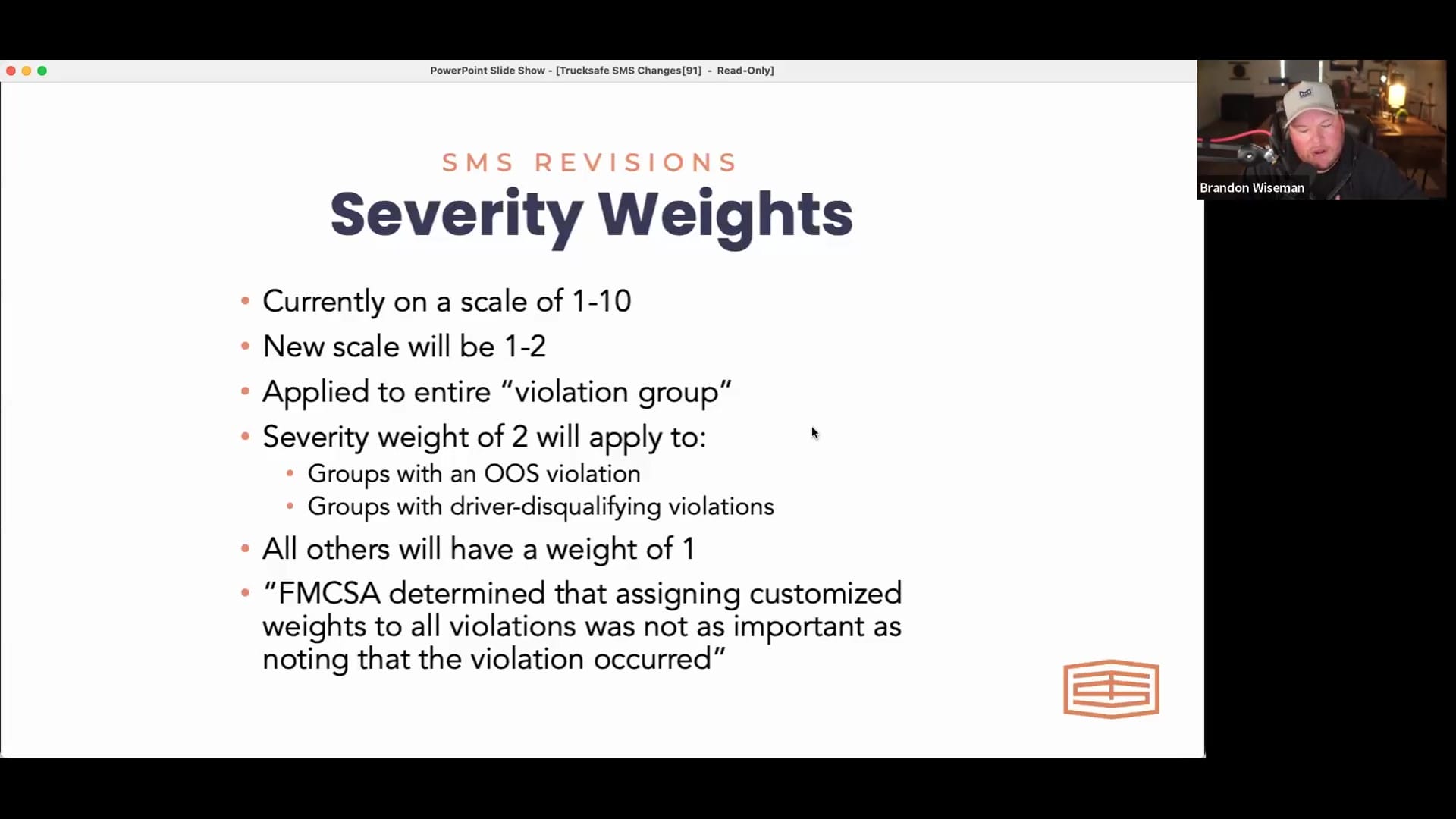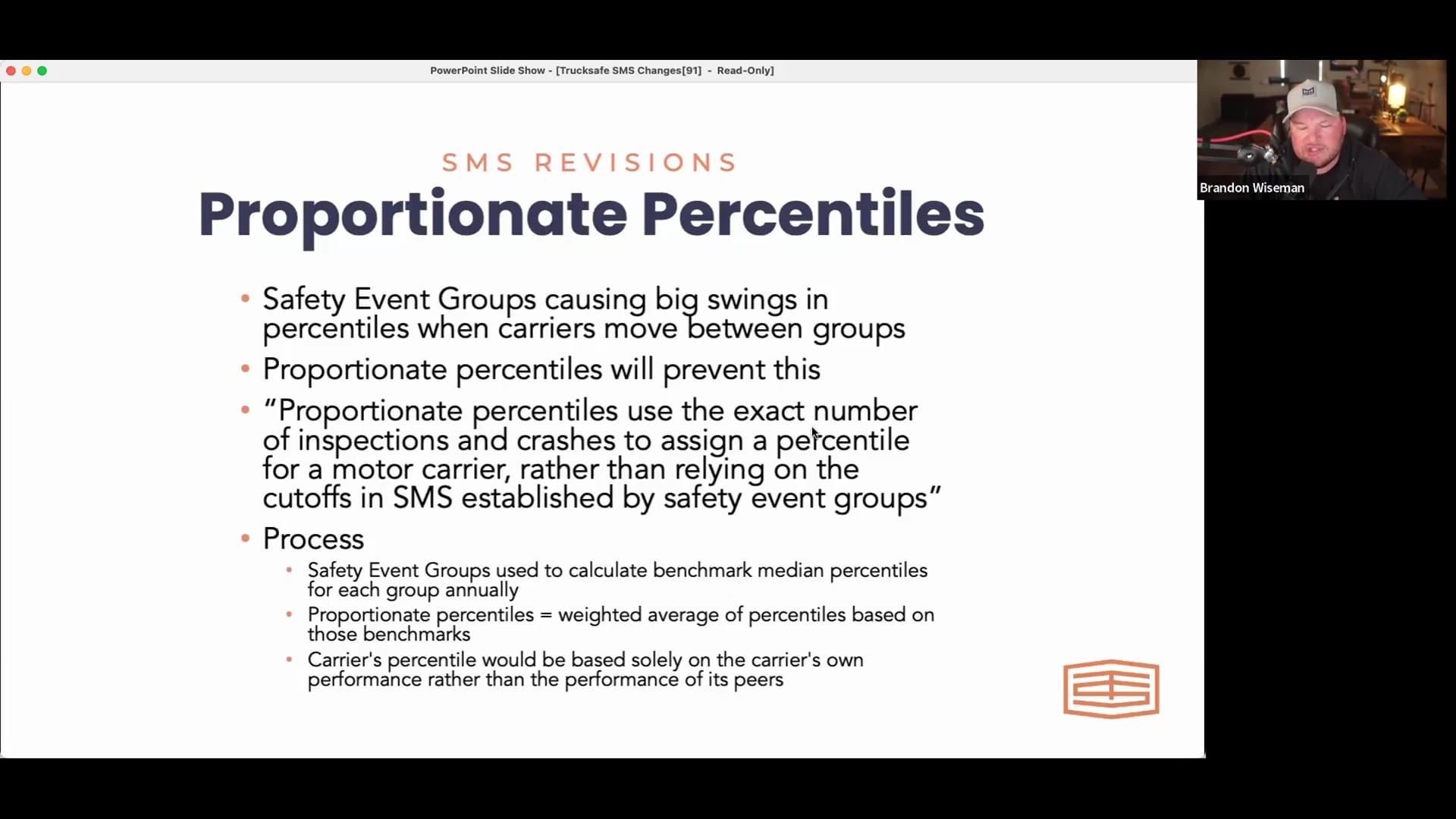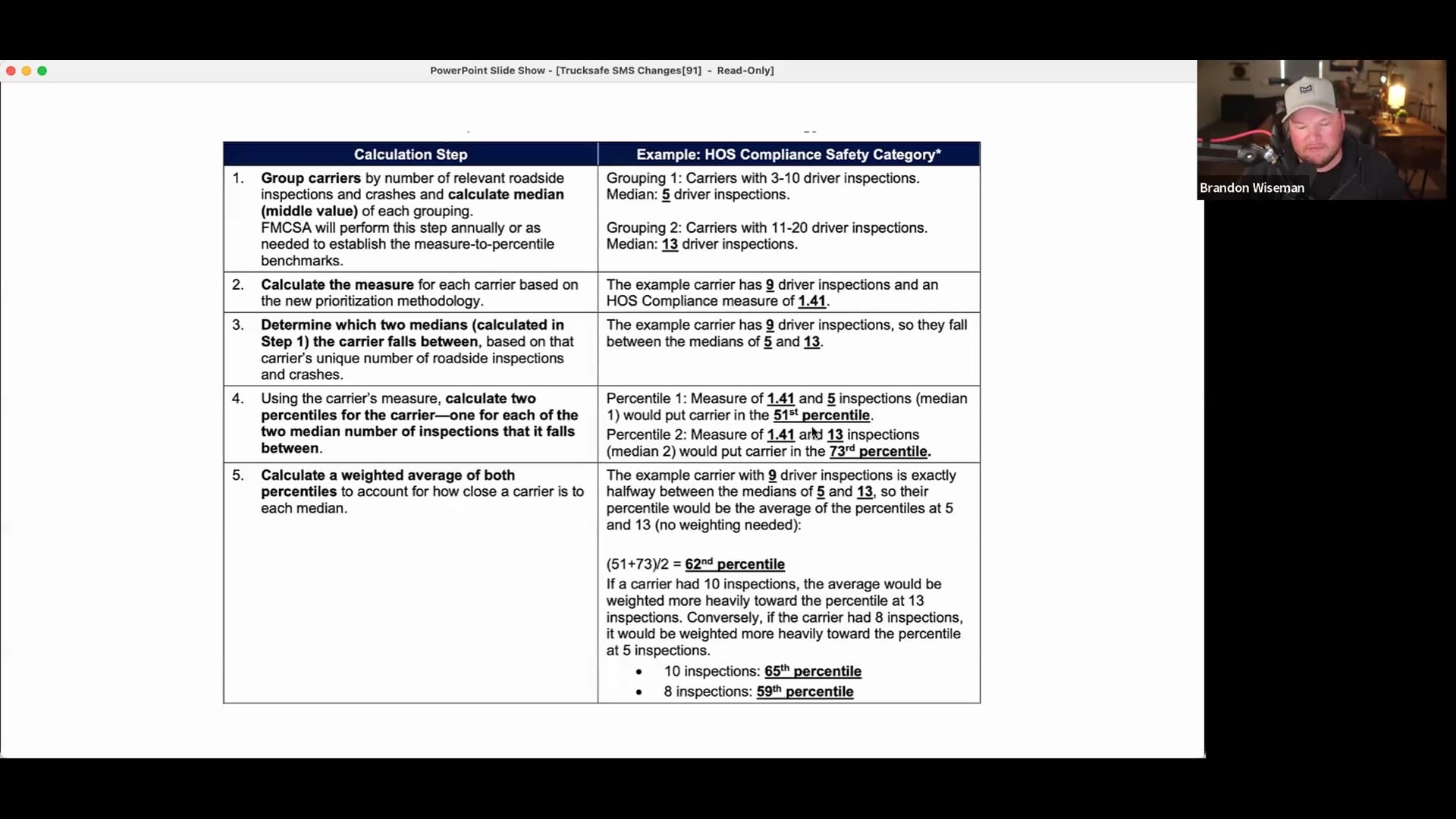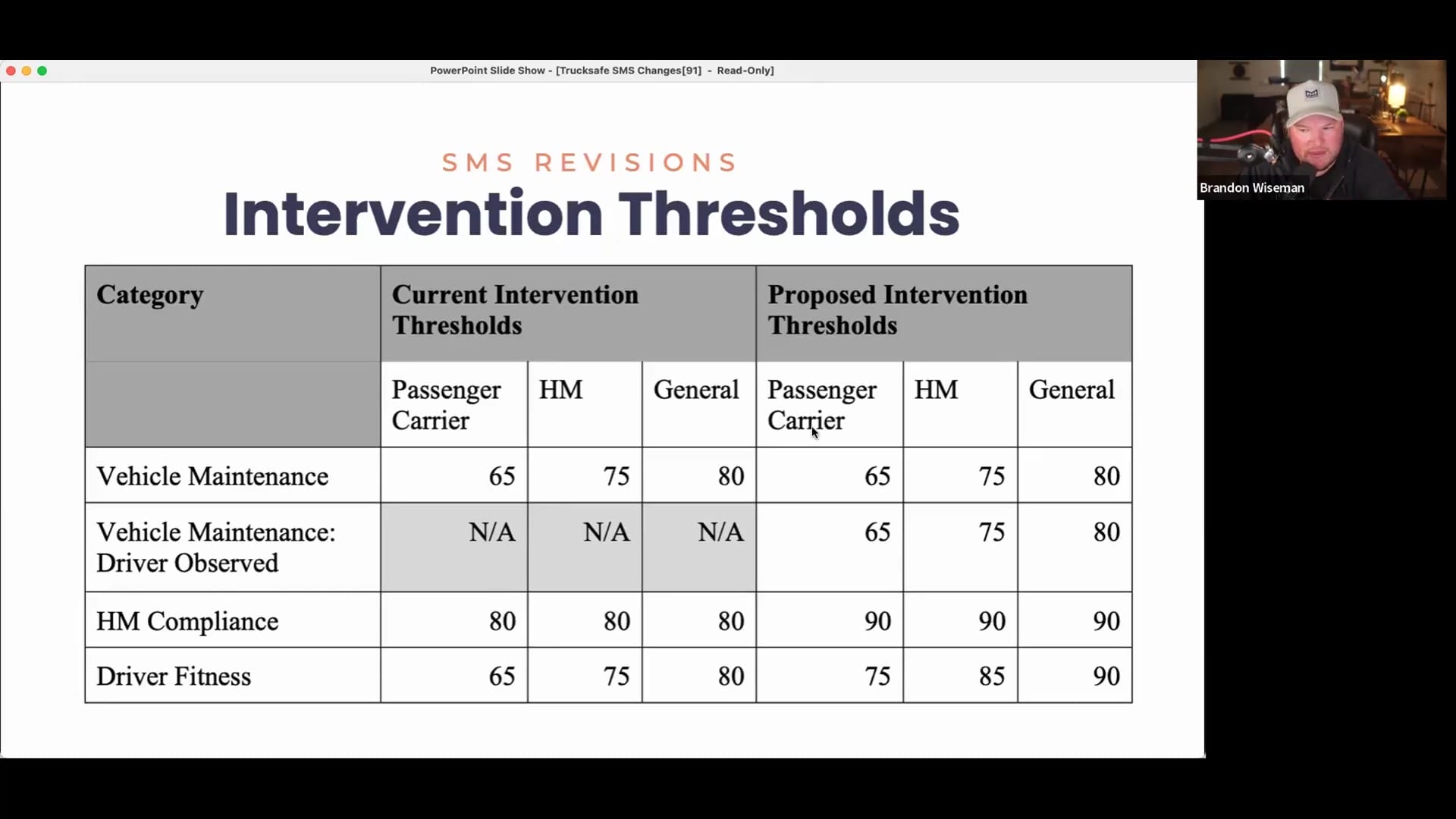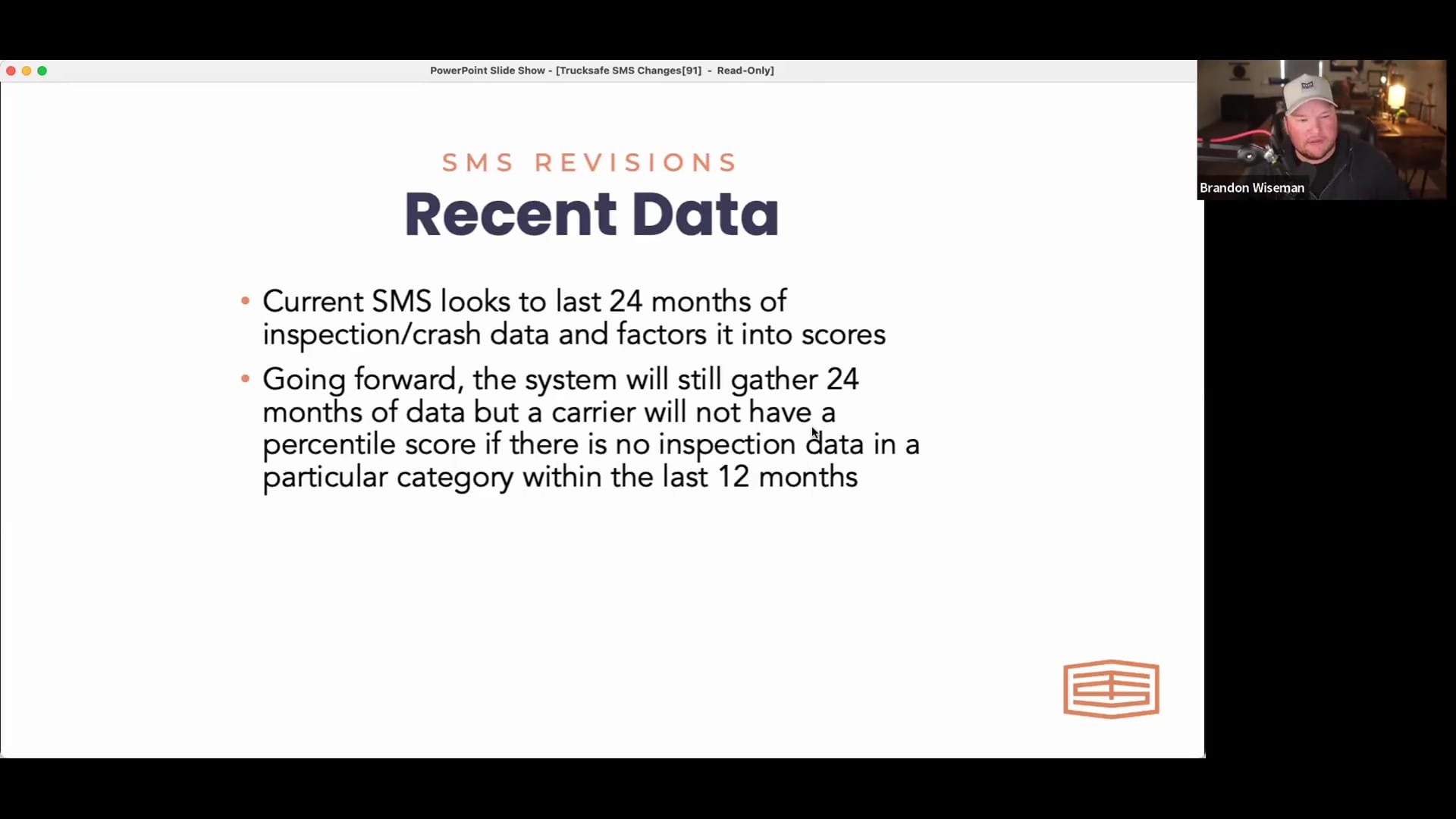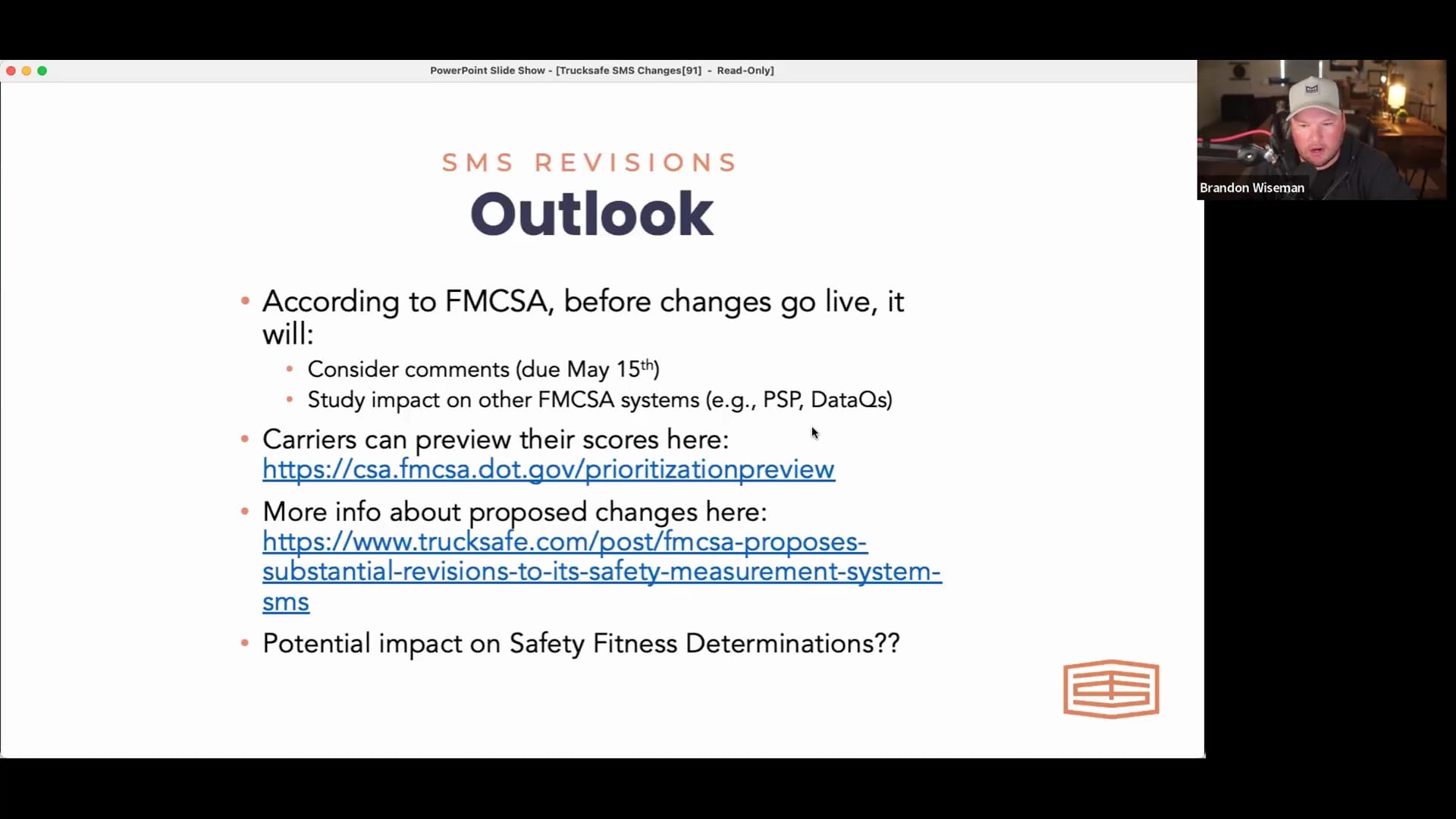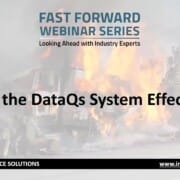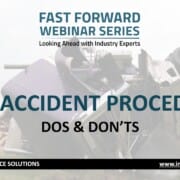Transcription
1
00:00:00.000 –> 00:00:01.180
Everyone and welcome.
2
00:00:02.260 –> 00:00:15.050
Mark Rhea: Good morning, everyone. My name is Mark Ray, and I wanted to welcome everyone to the Infinit-I Workforce Solutions Fast Forward Expert Round Table and Information Exchange this morning
3
00:00:15.230 –> 00:00:27.850
Mark Rhea: before we get started. If you don’t mind, open up your chat, tell me who you are. Tell me where you’re calling in from? No, we’ve got a lot of existing clients. We’ll say hello to everyone.
4
00:00:28.040 –> 00:00:39.500
Mark Rhea: We’ve got a tremendous program this morning. Special guest, subject matter, expert and voice of our industry, Mr. Brandon Wiseman.
5
00:00:39.740 –> 00:00:45.020
Mark Rhea: Well, truckssafe.com will be updating us on what we can expect
6
00:00:45.150 –> 00:00:50.310
Mark Rhea: with the upcoming changes in the SMS and the Csa program.
7
00:00:50.760 –> 00:01:03.170
Mark Rhea: So I know you’re gonna want to make sure to take close notes, because that in in impacts all of us. I also wanted to remind everyone. Next week is International Row check
8
00:01:03.600 –> 00:01:16.110
Mark Rhea: with a emphasis on anti break systems and cargo securement along with hours of service and medical cards and all the other things they’re going to check for. and we certainly want to support our
9
00:01:16.160 –> 00:01:27.100
Mark Rhea: Enforcement partners, Cbsa, and this most important initiative. And also i’d like to offer anyone. It’s not a subscriber
10
00:01:27.270 –> 00:01:35.280
Mark Rhea: to get a free demo. You can. If we got the pop up here. If you want a demonstration on our system.
11
00:01:35.350 –> 00:01:47.740
Mark Rhea: I did wanna make sure. You know we have some new content on anti-break systems brand new right off the shelf We’re going to include a link to that content with a follow up email.
12
00:01:47.900 –> 00:01:51.710
Mark Rhea: But if you want to get your drivers up to snuff
13
00:01:52.550 –> 00:01:55.800
Mark Rhea: on Abs, you can do that this afternoon
14
00:01:55.860 –> 00:02:11.620
Mark Rhea: if you’re an existing client, get that content out and and assigned, or if you want to sign up for the demonstration, I’m sure you’re a a customer Service representative can get you up and going and get some content out to
15
00:02:12.610 –> 00:02:24.760
Mark Rhea: pay our drivers and support our Enforcement partners in next Week’s International Road check. So if you want to, Demo, just check the Yes, we’ll give you another chance at the end of the session.
16
00:02:24.970 –> 00:02:36.140
Mark Rhea: But I wanted to get that out front and remind everybody. Next week is international road check, huge in in industry, based initiative. That’s been very successful. So
17
00:02:36.770 –> 00:02:46.350
Mark Rhea: with all that said, we’ve got a lot of people signed in and let’s get started Today’s subject again
18
00:02:46.860 –> 00:02:55.700
Mark Rhea: is SMS Safety Management Systems and Csa Compliance, safety, accountability programs.
19
00:02:55.840 –> 00:03:07.580
Mark Rhea: and what to expect on upcoming changes. Mr. Wiseman has been involved in some of the discussions on these changes. He supports. These changes. I don’t have to
20
00:03:07.780 –> 00:03:21.320
Mark Rhea: remind everybody the amount of resources our industry has invested. In Csa. The metrics are used by carriers, shippers, drivers, insurance companies.
21
00:03:21.600 –> 00:03:35.240
Mark Rhea: and yes, plaintiffs. Attorneys tend to use this as needed in their cases against us so very important information. Csa was rolled out 10 or 11 years ago.
22
00:03:35.360 –> 00:03:50.440
Mark Rhea: I can certainly attest to the resources and their anxiety that went along with that roll out. We’ve got some time. We made a few adjustments. It’s designed to improve highway safety through comparative metrics for commercial vehicles
23
00:03:51.170 –> 00:04:03.100
Mark Rhea: through that obtained through road side inspections, which we can expect a heavy presence on our highways next week from our Enforcement officers with international road check coming up, so
24
00:04:03.280 –> 00:04:13.670
Mark Rhea: with that being said, we’ve got Mr. Brandon Wiseman again. I want to make sure he is a voice of our industry. He supports all of our efforts. He understands our
25
00:04:13.720 –> 00:04:18.850
Mark Rhea: our industry insides. Now, the legality of that is an attorney.
26
00:04:18.959 –> 00:04:26.040
Mark Rhea: But more than that, I think he just understands the the reality of our industry.
27
00:04:26.300 –> 00:04:27.720
Mark Rhea: Brandon. Take it away.
28
00:04:27.900 –> 00:04:51.540
Brandon Wiseman: Thanks, Mark, and, thanks to Infinit-I for having me, I really appreciate it, thanks to everyone who’s joining us this morning and spending some of your time talking about the riveting topic of the safety measurement system. It’s an important topic, one that we have to discuss. Because if you are a regulated carrier as marked into that. And, as you know.
29
00:04:51.640 –> 00:04:59.840
Brandon Wiseman: the safety measurement system is a huge issue for you as a regulated carrier. It it impacts you in many ways.
30
00:05:00.010 –> 00:05:07.810
Mark listed a few of them. It can impact your commercial auto liability insurance premiums. If your scores aren’t up to snuff.
31
00:05:08.030 –> 00:05:27.640
Brandon Wiseman: it can keep you from doing business with the shippers and the brokers that you want to do business with, because a lot of them are looking at your scores through the system to see how you are performing from a compliance standpoint. So if your scores start to trend in the wrong direction, you very well could find yourself
32
00:05:27.640 –> 00:05:37.270
Brandon Wiseman: losing business because of it. And, most importantly of all, as Mark said, it is used by plaintiffs, attorneys in the context of highway accident, litigation.
33
00:05:37.320 –> 00:05:56.050
Brandon Wiseman: It is used to paint you as a bad actor. It is used to demonstrate to the jury that you don’t care about safety, whether that data actually supports that or not, it will be used in that way. And so it is important. It is critical for motor carriers to keep an eye on
34
00:05:56.050 –> 00:06:07.230
Brandon Wiseman: their Csa scores, and do everything in their power to improve those scores over time. And so the reason it is particularly important that we talk about this topic today.
35
00:06:07.390 –> 00:06:13.360
Brandon Wiseman: because the system, as we know it, and as we have known it since 2,010,
36
00:06:13.760 –> 00:06:16.770
Brandon Wiseman: we’ll be undergoing some pretty significant changes here
37
00:06:17.110 –> 00:06:26.010
over the course of the next several months, probably not within the next couple of months. More than likely. These changes that we’re going to talk about today
38
00:06:26.220 –> 00:06:40.030
Brandon Wiseman: will come to be at the end of this year at the earliest, if not, if not, then, and it’s probably going to be next year sometime. But it’s worth spending time now, understanding how these changes might impact your scores
39
00:06:40.030 –> 00:06:52.530
Brandon Wiseman: so that you can, so that you can see exactly what’s going to happen to them, and so you can be prepared for them. So that’s what we’re going to talk about today. Here’s kind of the agenda that I would like to follow as we go along here.
40
00:06:52.710 –> 00:07:05.320
Brandon Wiseman: make sure to put your questions in the Q. And a. Box, and you know we’ll either get to them as we go along, or we’ll certainly have some time at the end. Hopefully to answer questions specifically. But
41
00:07:05.380 –> 00:07:21.670
Brandon Wiseman: here here’s what i’m planning. I’m: I’m going to first talk about kind of the background of the safety measurement system. What it is, how it works. I think it’s important. We start there to get an understanding of how the system works currently to make sure you’ve got a good grasp on that.
42
00:07:21.740 –> 00:07:37.260
Brandon Wiseman: so that we can better understand what exactly is changing. We’ll talk about some of the criticisms about the current system over the years, and where that has taken us particularly with respect to some Congressional action.
43
00:07:37.320 –> 00:07:50.640
Us. Congress stepped in, told Fmcs that they had to do something about the system in light of the criticisms it has received. and that that brings us to the point we’re at now, where Fmcsa is now proposing some changes.
44
00:07:50.890 –> 00:07:52.580
Brandon Wiseman: and then we’ll dig in deep.
45
00:07:52.610 –> 00:08:09.330
The proposed changes, at least the main ones. I think there are 5 or 6 main changes that are likely to take effect. and then we will end with kind of my outlook on where I see things going over the next several months with the system and with your Csa scores.
46
00:08:09.490 –> 00:08:27.190
Brandon Wiseman: So, without any further ado, let’s start with kind of a background of safety measurement system. What is it? How did it come to be? What is it doing? That type of stuff? So SMS safety measurement system is part of a broader program. Many of you may know this already, so I apologize for
47
00:08:27.270 –> 00:08:45.640
Brandon Wiseman: kind of getting into it here. But, like I said, it’s important that we at least have this first kind of foundational understanding of where we’re at currently, so that we better understand it. Why things are changing, and how exactly they are changing. SMS is part of the broader compliance, safety, accountability, system. Csa.
48
00:08:45.650 –> 00:09:00.650
Brandon Wiseman: That’s why a lot of folks tend to know these as Csa scores, Csa is actually describing a broader system than just scores, but it it’s just colloquially known as Csa scores, or has come to be known as them.
49
00:09:00.690 –> 00:09:20.350
Brandon Wiseman: When somebody is talking about Csa scores what they are actually talking about. Our SMS Scores safety measurement system, which again, is part of the broader Csa platform. Csa. The broader system really describes all of the enforcement tools that are available to the Federal motor carrier Safety Administration, including things like warning letters.
50
00:09:20.360 –> 00:09:36.870
Brandon Wiseman: your safety ratings, audits, all of those various tools that they have to enforce their Federal motor carrier. Safety regulations are all rolled up under Csa. That platform Csa platform was first implemented back in 2,010,
51
00:09:37.030 –> 00:09:45.780
Brandon Wiseman: and it’s really it’s really in existence, because the Fmcs. A many of you may know.
52
00:09:45.780 –> 00:09:57.260
Brandon Wiseman: relatively speaking, is a fairly small Federal agency, as Federal agencies go even compared to other agencies that fall under the umbrella of the United States Department of Transportation.
53
00:09:57.320 –> 00:10:05.260
You know, under that umbrella we have other agencies like the Federal aviation administration, which is huge in comparison to the fmcsa.
54
00:10:05.340 –> 00:10:16.110
Brandon Wiseman: The fmcsa, as you know, is the agency that is responsible for regulating interstate the interstate operation of commercial motor vehicles so highway transportation.
55
00:10:17.050 –> 00:10:23.640
Brandon Wiseman: I think, at the the last I saw at any given moment Fmcsa has about a 1,000 employees, total
56
00:10:23.870 –> 00:10:31.550
and that group of individuals a 1,000 employees is in charge of regulating now over 700,000
57
00:10:31.840 –> 00:10:40.220
Brandon Wiseman: registered motor carriers in the United States, so they just Don’t have the manpower to get out and enforce their regulations
58
00:10:40.260 –> 00:10:50.470
via audits, or anything like that, with any significant percentage of the regulated motor carriers. So what they have to do is they have to prioritise motor carriers. The worst
59
00:10:50.520 –> 00:10:56.850
performing motor carriers to escalate for further enforcement, usually in the form of an audit
60
00:10:56.920 –> 00:11:14.040
Brandon Wiseman: that is the whole rationale for the Csa platform. Congress stepped in and said, we got to do something because the fmcsa is just not able to adequately enforce the regulation. So we have to figure out a way to prioritize the worst for performing motor carriers.
61
00:11:14.040 –> 00:11:40.780
Brandon Wiseman: The ways that we do that now are primarily through the Csa platform, and specifically through the safety measurement system, which is in essence the primary enforcement prioritisation tool that the Fmcsa uses. It is the way that the fmcsa prioritises you for fines and audits and things like that. How does it do that? It does it through a scoring system known as the safety measurement system.
62
00:11:41.180 –> 00:11:57.410
Brandon Wiseman: This SMS system. Many of you again, may know all of this, so apologize for repeating, but it is a system that is gathering a lot of data from different sources, primarily from roadside inspections as your trucks, and as your drivers are out there operating
63
00:11:57.410 –> 00:12:07.190
and incurring roadside inspections and violations, get written up on the inspection reports. All of that data gets put into the system safety measurement system
64
00:12:07.470 –> 00:12:23.770
Brandon Wiseman: along with data from any audit. So if you happen to undergo a D Ot. Audit, and they write you up for violations in that audit critical and acute violations. Those are also populating in the safety measurement system. But primarily the main data source. Here
65
00:12:23.940 –> 00:12:49.650
Brandon Wiseman: is the violations are the violations that you are incurring during roadside inspections. All of that gets brought into the system. and then split out into 7 categories which are known as the basics, the Behavioral analysis, safety, improvement categories. It’s a mouthful. Luckily we’ll talk about later. That’s one of the things that’s changing. We’re getting rid of that acronym. We can just call them safety categories going forward.
66
00:12:49.770 –> 00:13:09.130
But all of the violations that you are incurring are getting split up into one of these 7 basics. 7 basics are listed out here. This may be a screen hopefully that is familiar to you if you are a regulated carrier. This is a a detailed look at a sample safety measurement system account.
67
00:13:09.130 –> 00:13:25.550
Brandon Wiseman: These are the 7 basics that you would see if you were to log into your account today. This is how it would look. 7 basics are unsafe driving. Those are going to encompass violations like speeding and lane change violations, failing to
68
00:13:25.550 –> 00:13:34.050
failing to comply with traffic control devices. All of those traffic type violations get put into the unsafe driving category.
69
00:13:34.150 –> 00:13:49.650
Brandon Wiseman: But crash indicator basic is the second one, and it encompasses all d ot recordable accidents in which your drivers and trucks are involved, regardless of whether you’re they your fault or not, they get put into your crash indicator score.
70
00:13:49.670 –> 00:14:02.560
Brandon Wiseman: There is now a crash preventability determination program that we can get into in a little bit. But suffice it to say for [email protected] accidents.
71
00:14:02.610 –> 00:14:05.240
The hours of service category is the third one.
72
00:14:05.470 –> 00:14:18.510
Brandon Wiseman: This is where all of the hours of service violations get put. So your 11 h violations, your 14 h violations, 30 min rest, break false logs, eld violations, all of those get put on your hours of service.
73
00:14:18.570 –> 00:14:31.680
Basic vehicle. Maintenance is the next one. It is the largest basic of them all, meaning. It has the most data in it of them all, which is spurring a a proposed change that we’ll talk about in a minute.
74
00:14:31.730 –> 00:14:45.140
Brandon Wiseman: But vehicle maintenance includes all of the maintenance-related defects that you would expect. So breaks, lights, tire problems all of those and also cargo securement violations. Get put on your vehicle maintenance, score.
75
00:14:45.340 –> 00:15:00.970
Brandon Wiseman: drug and alcohol is the next one encompasses not necessarily positive drug and alcohol tests those aren’t. The types of things that get put into that category here. This is a category that encompasses on the road
76
00:15:01.030 –> 00:15:19.120
drug and alcohol violations if you happen to have them. So if a driver gets a dui while operating a commercial motor vehicle or gets stopped, and an officer finds drugs or alcohol in the in the cab of the vehicle. Those are the types of violations that get put on your drug and alcohol score
77
00:15:19.250 –> 00:15:27.460
Brandon Wiseman: hazmat, which encompasses all hazmat violations if you happen to haul it. So placarding violations, shipping paper violations.
78
00:15:27.570 –> 00:15:32.090
those types of things. And then, lastly, driver fitness is the last basic
79
00:15:32.130 –> 00:15:40.910
Brandon Wiseman: driver. Fitness encompasses driver qualification type violations. So, having the wrong licence or having no licence
80
00:15:40.940 –> 00:15:46.020
Brandon Wiseman: having an expired med card. All of those things that go into qualifying
81
00:15:46.240 –> 00:16:04.780
Brandon Wiseman: a commercial driver. Anything you get wrong there gets put on your driver fitness score. So that’s how it goes for month to month. The system is bringing in roadside inspection violation data, and it is categorizing it into these 7 basics for every one of the 700,000 plus regulated motor carriers.
82
00:16:04.950 –> 00:16:22.720
Brandon Wiseman: Then the other things to know about the system is that we have what are called absolute measures and percentile measures. An absolute measure is just describing your scores relative to yourself. So every month you’re having new violations, maybe put on a particular category.
83
00:16:22.720 –> 00:16:41.860
Brandon Wiseman: And then the system is calculating your particular absolute measure score in that category. In that month the system is bringing in data for the last 24 months after 24 months. It no longer impacts your scores. But anything that has happened in these categories over the past 24 months
84
00:16:41.860 –> 00:16:59.010
Brandon Wiseman: is impacting your absolute measure score. How is an absolute measure score calculated? It is calculated by taking each of those violations under the current SMS methodology, each violation, I think there are 950 or so potential violations
85
00:16:59.010 –> 00:17:17.490
Brandon Wiseman: that can impact your scores. Each one of those is given a what’s called a severity weight, depending on how serious it is, or more likely to cause a crash if you go in and and search for the SMS methodology. Now you’ll find a several 100 page document. You could just Google this and find it.
86
00:17:17.490 –> 00:17:30.700
Brandon Wiseman: It details exactly how your scores are currently calculated. It’s a document that I’ve read more than I care to admit, but it’s out there if you want to see it. But there, at the end of that document is the entire table
87
00:17:30.750 –> 00:17:46.580
Brandon Wiseman: of the severity weights that apply to those 950 or so violations on a scale of one to 10. The more serious violations are going to carry a heavier severity, weight than a more minor violation. An example of a tin pointer
88
00:17:46.580 –> 00:17:58.790
Brandon Wiseman: is going to be what the types of violations you would expect to carry the most weight, using a driver after he or she has tested positive for drugs or alcohol, for example, would be a serious violation, whereas
89
00:17:58.870 –> 00:18:13.890
a a form and man or violation on your driver logs. They forget to put the the shipping paper number or the trailer number on their log. That’s a relatively minor violation. So each of those violations gets a severity weight.
90
00:18:14.620 –> 00:18:33.470
Brandon Wiseman: and then the violation is multiplied. The severity weight is multiplied by a time weight. Violations that have occurred more recently carry a greater time weight than violations that are older, If it’s within the last 6 months it has a time weight of 3, if it’s between 6 and 12 months. It has a time weight of 2, if it’s
91
00:18:33.470 –> 00:18:43.980
Brandon Wiseman: older than a year between 12 months and 24 months, then it has a time weight of one, and then, after 24 months, it falls off completely. So your severity weight times your times weight.
92
00:18:43.980 –> 00:19:00.050
Brandon Wiseman: equals your total weight for each violation that’s in each category. And then those all get added up, whatever those numbers happen to be, and you get an absolute measure. You could see the absolute measure here in this example. It’s the top number right under the icons. There
93
00:19:00.050 –> 00:19:11.410
Brandon Wiseman: you could see unsafe driving. It’s a little bit cut off the measure there the absolute measure is 9.5. Does that mean anything to you standing alone? Probably not. What does 9.5 mean? Nothing.
94
00:19:11.480 –> 00:19:17.450
Brandon Wiseman: It is telling you how you are what your score is on this particular month in that category.
95
00:19:17.620 –> 00:19:33.950
Brandon Wiseman: What’s more interesting, and what’s more important to you, are your percentile scores. We’ve got absolute measures. Those are specific to me. Your percentile score are what are known as your Csa scores or your SMS scores. Those are telling you how you are performing relative to your peers.
96
00:19:33.950 –> 00:19:37.670
Those are your Csa scores. That’s what everybody is interested in.
97
00:19:37.930 –> 00:19:46.980
Brandon Wiseman: How are those calculated? They are essentially calculated by putting every regulated motor carrier in each category in what are called safety event groups.
98
00:19:47.110 –> 00:19:53.320
It would be fundamentally unfair if the system were ranking all motor carriers together.
99
00:19:53.490 –> 00:20:13.170
Brandon Wiseman: It would be unfair to have a carrier that has one inspection with a violation in unsafe driving being ranked against a carrier that has hundreds or thousands of violations in that category. It’s just not apples to apples. So what the system does currently is, it places us in safety event groups that are based primarily on
100
00:20:13.170 –> 00:20:28.150
Brandon Wiseman: the number of inspections with violations you’ve had in each of the categories. So you’ll be in a safety event group in each of the categories depending on your inspection activity. If you’ve had 10 inspections with violations in the hours of service
101
00:20:28.190 –> 00:20:38.530
Brandon Wiseman: basic within the last 24 months, then you are going to be compared against other carriers that have a similar number of inspections with violations over that time period.
102
00:20:38.530 –> 00:20:48.590
Brandon Wiseman: And then it puts you on a scale a percentile scale based on how you are performing relative to the others with a similar number of inspections with violations.
103
00:20:48.660 –> 00:20:57.170
Brandon Wiseman: So the when you see a percentile score. In a basic, for example, this carrier in this example has an 86%
104
00:20:57.280 –> 00:21:10.100
Brandon Wiseman: score in the unsafe driving category. What that is telling you is that this carrier is performing worse than 86% of its peers in its safety Event group as of this month.
105
00:21:10.190 –> 00:21:12.870
Brandon Wiseman: That is what your percentile score is telling you
106
00:21:12.970 –> 00:21:16.830
Brandon Wiseman: you are performing relative to your peers. So
107
00:21:17.190 –> 00:21:19.810
Brandon Wiseman: the higher the score, the worse off you are.
108
00:21:20.040 –> 00:21:36.670
Brandon Wiseman: The other thing to know here is that, you know. Aside from just comparing you to your peer groups, the percentile scores are also important from a regulatory standpoint, because the fmcsa has set in each of those categories what are called intervention thresholds.
109
00:21:36.680 –> 00:21:49.420
It is a specific, percentile score in each of the basics, where, if you exceed that score in a particular month you are going to get that nice big warning triangle on your score that we see in this example
110
00:21:49.850 –> 00:21:58.550
Brandon Wiseman: the score, the the intervention threshold changes based on your the type of carrier that you are. There’s a separate score for
111
00:21:58.790 –> 00:22:12.640
Brandon Wiseman: general commodity carriers. There is one for hazmat carriers, and there is one for passenger carriers, so depending on which of those categories you fall in that dictates what your intervention threshold is going to be in each of the basics.
112
00:22:12.700 –> 00:22:22.920
Brandon Wiseman: and then from each of the basics there is a separate score. So, for example, the vehicle maintenance intervention, threshold for general commodity carriers is currently 80%.
113
00:22:23.060 –> 00:22:33.460
Brandon Wiseman: So if you’re performing worse than 80% on a particular month in the vehicle maintenance category and you’re a general commodities, Carrier. Then you’re going to have that warning triangle. Put on your score
114
00:22:33.700 –> 00:22:49.590
Brandon Wiseman: the the most common intervention thresholds for general commodity. Carriers are are 65% or 80. So some of the basics are 65. Some of them are 80, and we’ll talk about in a little bit how some of those are are going to be changing here soon.
115
00:22:49.590 –> 00:22:59.530
But you you’re trying to avoid that warning triangle at all cost. You’re trying to keep your scores below those intervention thresholds in each of the basics, because bad things happen
116
00:22:59.530 –> 00:23:10.480
Brandon Wiseman: when you exceed the intervention thresholds. It’s not just the warning triangle. What does that warning triangle mean? It means you are now prioritized for enforcement from an fmcsa standpoint.
117
00:23:10.550 –> 00:23:27.690
Brandon Wiseman: So that’s what the Fmcsa. And their Enforcement partners, their State law enforcement partners are looking at to see who should we go in and do an audit. They are looking at carriers that are having trouble, namely, those that have basics in the so called alert status.
118
00:23:27.730 –> 00:23:33.080
Brandon Wiseman: Now, in my experience kind of depends where you happen to be located in the country.
119
00:23:33.300 –> 00:23:40.400
Brandon Wiseman: But usually it’s been my experience that carriers that have one basic in alert status on a given month
120
00:23:40.540 –> 00:23:53.560
Brandon Wiseman: are not likely to get audited because of that. It’s usually carriers that have 2 or more basics in alert status. When I start to become worried about a potential audit or something to that effect. Again, that’s not universally true.
121
00:23:53.620 –> 00:24:12.450
Brandon Wiseman: Sometimes even a single basic and alert status will prompt an audit, but it’s when you start to get multiple basics in alert status where the fmcsa really starts to take notice, and then you may get the knock at the door that you don’t want to get where they say it’s time to come in and take a look at your records.
122
00:24:12.450 –> 00:24:31.550
Brandon Wiseman: so just be aware of that, but also again, we also mentioned at the start some of the others that are looking at your scores, and they are also looking to see. Do you have any of these warning triangles on your scores, namely, your commercial auto liability insurers, and also your customers Those, and and certainly plaintiffs attorneys.
123
00:24:31.780 –> 00:24:41.140
Brandon Wiseman: if you’ve got more than if you’ve got any of your basics in alert status, it’s going to negatively impact your commercial auto liability, insurance premiums.
124
00:24:41.140 –> 00:24:57.640
Brandon Wiseman: your relationships with your customers potentially. And also, God forbid! You get involved in a catastrophic accident that is going to come to light in that litigation, and the story that is going to be told to the jury in that case is, look look at the carrier’s scores here they’ve got.
125
00:24:57.640 –> 00:25:15.200
Brandon Wiseman: They’re performing worse than this percentage of their peers in this category. How can we let them continue operating? We have to punish them for their bad behavior here, and that’s what is leading to these multi 1 million dollar verdicts that we see in some of these highway accident litigation cases. So.
126
00:25:15.200 –> 00:25:32.220
Brandon Wiseman: and and Brandon just a plans turning all they need is a motor carrier number to access that information. Is that correct? Yeah. So the thing that that’s a good point mark the other thing to know. You may know this already if you’ve been dealing with SMS for a while, is that for for a long, not for a long time, actually for a very short period of time.
127
00:25:32.220 –> 00:25:49.500
Brandon Wiseman: These percentile scores that we’re showing here were publicly available for anybody to see that has changed. That changed shortly after Fmcsa published the Csa program because of criticisms in the industry, and that is what we are getting into here in a second
128
00:25:49.500 –> 00:26:03.710
Brandon Wiseman: Fmcs. They got a lot of blowback about this scoring system folks in the industry concerned about whether the data was reliable, and whether it accurately identified motor cures that were more likely to cause crashes
129
00:26:03.710 –> 00:26:20.890
because of that criticism the Us. Congress got involved and actually demanded, directed the Fmcsa to remove from public view these percentile scores. So now, if you have a dot number you can log on, and you can get access to all of the underlying data
130
00:26:20.890 –> 00:26:34.280
for any regulated motor carrier. What I mean by underlying data, all of the roadside inspection data that is filtering into the system. You can also see their absolute measure scores. But you can’t see
131
00:26:34.360 –> 00:26:50.000
Brandon Wiseman: the percentile scores or these warning triangles for motor carriers, that for any motor carrier, unless you are logging into your own personal account, you have to have a a password essentially your Us doot PIN number to see what your actual percentile score is.
132
00:26:50.010 –> 00:26:59.800
and then certainly law enforcement has access to your percentile scores. So you’re probably asking, Well, how do those other groups get access to my scores, then to to see how i’m performing
133
00:26:59.960 –> 00:27:17.710
Brandon Wiseman: insurance groups get access to your scores, either by getting you to provide them your PIN number to log in, or there have come to be third-party platforms out there. That do a pretty good job of estimating what your percentile score is. If you hear a lot of talk about cab reports
134
00:27:17.710 –> 00:27:27.540
that insurance groups use it’s essentially a system that is estimating what your your percentile score is, and, like I said, they are pretty close to accurate. So even though
135
00:27:27.630 –> 00:27:40.980
Brandon Wiseman: your scores are technically not publicly available, if you’re a general commodities. Carrier, passenger, carrier, scores are still available to the public. But if you’re a a general commodities, holler or a hazmat hauler, and you don’t haul passengers.
136
00:27:41.150 –> 00:27:47.840
Brandon Wiseman: even though your scores aren’t publicly available. Technically. people can still essentially estimate what they are and get access to them.
137
00:27:48.860 –> 00:27:59.670
So that takes us to the industry, criticism. What have folks been complaining about the system? Why have they been complaining? And I have been right there with you, complaining about these things for years.
138
00:27:59.730 –> 00:28:12.250
There’s a lot of problems with the system, and and whether it does what it claims to do, which is to prioritize the worst offending motor carriers. Does it do a good job of that? Does it
139
00:28:12.250 –> 00:28:35.340
Brandon Wiseman: do a good job of predicting future crash risk, and a lot of folks have said, No, it doesn’t do that, and a lot of studies have suggested that it doesn’t do a great job of identifying the highest risk Motor carriers for a number of reasons. I’ve listed the amount a few of them here, including disparate enforcement. This has been a big criticism of the of the platform for years.
140
00:28:35.340 –> 00:28:53.950
Brandon Wiseman: where carriers that happen to be situated in particular areas of the country have relatively higher scores than similarly situated carriers in other areas of the country, because of the way that certain States enforce their laws. For example, Indiana is notorious for having
141
00:28:53.950 –> 00:29:00.160
Brandon Wiseman: carriers with the highest unsafe driving scores in the country, because Indiana is particularly aggressive
142
00:29:00.160 –> 00:29:16.280
when it comes to speeding violations. So if you have a lot of vehicles working through or operating through Indiana, then it’s very likely that you have an elevated, unsafe, driving score compared to carriers that Don’t have as much Indiana operations
143
00:29:16.280 –> 00:29:25.790
Brandon Wiseman: that’s not fair, because it shouldn’t be the places in the country that dictate whether we are an unsafe carrier or not under SMS.
144
00:29:25.830 –> 00:29:38.030
Brandon Wiseman: So there are things like that that have kind of bubbled to the surface over the years, and that have gotten the ear of the Us. Congress. Us. Congress steps in in 2,015, with the fast act.
145
00:29:38.080 –> 00:29:53.590
Brandon Wiseman: Many of you may recall this. This is the act that not only removed from public view the public scores or the percentile scores, but more importantly directed the Fmcsa. To commission an independent study of SMS,
146
00:29:53.620 –> 00:29:59.420
Brandon Wiseman: and then to implement any recommendations that that independent study may have proposed.
147
00:29:59.620 –> 00:30:15.000
Brandon Wiseman: That study took place over the last several years. It was the National Academy of Sciences, Nas. That conducted the study, and they developed a report. They put together a report. Their findings were issued in 2,017,
148
00:30:15.970 –> 00:30:32.530
Brandon Wiseman: surprisingly to a lot of us in the industry. NASA’s main finding was that SMS is conceptually sound. In other words, they didn’t tear it apart like what he had hoped that they would tear it apart. They found that overall it was conceptually sound.
149
00:30:32.550 –> 00:30:45.810
Brandon Wiseman: It did note that that the system appeared to have some data quality problems, and so they proposed, or they they put forth a recommendation that said. Even though the system is statistically principled.
150
00:30:46.200 –> 00:30:50.470
Brandon Wiseman: they would recommend that the fmcsa. Consider a new model
151
00:30:50.490 –> 00:31:04.610
Brandon Wiseman: to identify motor carriers that need intervention, and the model that they had proposed was a model called the item response theory. Ir T. Model. You’ve probably heard this term thrown around. What is it? It’s it’s a very complex.
152
00:31:04.620 –> 00:31:21.630
Brandon Wiseman: a statistical model that is used in other industries. It is used in standardized testing for like sat and stuff like that. It’s a scoring model that is commonly used in other industries. It’s the one that Nas recommended Fmcs a consider moving to
153
00:31:21.750 –> 00:31:25.980
away from what they currently have into an item response theory. Model
154
00:31:25.990 –> 00:31:32.130
Brandon Wiseman: Fmcs: a. Over the last couple of years has been testing has been piloting an IoT model.
155
00:31:32.400 –> 00:31:45.090
Brandon Wiseman: But this is the first big takeaway here, Fmcsa: in in a recent publication that has kind of spurred this discussion that we’re having today has said we are not going to an IoT model.
156
00:31:45.350 –> 00:32:05.220
Brandon Wiseman: Nas be damned. We don’t care what they say. We have studied the model. We don’t like the model they listed out a handful of issues that they had with that model. But my take away from their publication recently was that they just thought the model was too complex. It is too hard to understand
157
00:32:05.250 –> 00:32:16.880
Brandon Wiseman: exactly how scores are calculated using that model. It just it’s way too complex, so they have disposed of the I Rt. Model. We are not moving to an IoT model. Okay?
158
00:32:16.880 –> 00:32:26.070
Brandon Wiseman: So that takes us to what exactly is changing. What are we doing, then, if we’re not moving to the IoT model that the national of Academies of Sciences has recommended?
159
00:32:26.110 –> 00:32:31.220
Brandon Wiseman: Well, Fmcsa is proposing their own changes to their existing system.
160
00:32:31.240 –> 00:32:48.680
Brandon Wiseman: They are proposing, like, I said, a handful of changes to the existing system, not disregarding it completely, not moving to a completely new model. We are going to keep the foundations of the safety measurement system that we have in place now, and we are going to make a handful of tweaks to it
161
00:32:48.680 –> 00:33:10.330
Brandon Wiseman: to address some of these concerns that have been raised over the years. So let’s get into what are these changes? As I said, there are a handful of them that I think are worth mentioning. There is more to it than this. If you are interested in reading the nitty, gritty details of the proposed changes. Fmcsa has a pretty good document on this topic. The New Methodology.
162
00:33:10.330 –> 00:33:35.990
This is on their SMS changes website. They have a specific website, a dedicated website set up for this. and I recommend you Check that out. If you haven’t already done this, you can actually, if you’re a regulated motor carrier you can log in to your current SMS account and click a link, and see how your scores will be changing. Once these proposed changes go into effect. I recommend you do that to see how these are likely to impact you.
163
00:33:35.990 –> 00:33:47.520
You. You could take a look at that now, and if you see problems with it. What’s today today is the eleventh. The comment period for these proposed changes is still open for a few more days to the fifteenth. I believe of May
164
00:33:47.650 –> 00:34:05.100
Brandon Wiseman: that may get extended. We’ll have to wait and see. But right now go in. Play around in the system. If you see problems, get your comments in, so that the fmcsa can review those issues and address them before these proposed changes go into effect. We are in a proposal stage now, as I said at the start.
165
00:34:05.100 –> 00:34:09.310
I don’t anticipate these changes going into effect any time in the near future.
166
00:34:09.630 –> 00:34:15.260
Brandon Wiseman: At earliest. It will probably be the end of this year if I had to guess, if not next year. All right.
167
00:34:15.449 –> 00:34:20.050
So here are the handful of major proposed changes that we’re talking about.
168
00:34:20.320 –> 00:34:30.000
Brandon Wiseman: They are a reorganization of the basics into what are called safety categories. consolidation of violations into into violation, groups.
169
00:34:30.250 –> 00:34:34.770
simplified severity, weights. proportionate percentiles.
170
00:34:34.909 –> 00:34:48.030
Brandon Wiseman: a modification to the intervention thresholds that we talked about in a heightened focus on more recent data. We’re going to tackle these one by one. Here again, as we go along. feel free to drop some questions in, and we’ll get to them
171
00:34:48.170 –> 00:35:03.970
Brandon Wiseman: all right. So first up are reorganizing the basics into safety categories. Those 7 basics that I mentioned at the start. That’s what we have. Currently. That is not what we’re going to have under these proposed changes. We are still going to have 7 basics, but they’re not going to be the same.
172
00:35:04.150 –> 00:35:06.700
They are going to be a little bit different.
173
00:35:06.970 –> 00:35:13.960
Brandon Wiseman: Most of them will be the same, but there will be a few differences. Number one. The first part of this change is like, I said.
174
00:35:14.040 –> 00:35:19.980
name change. We’re not going to call these basics anymore. We are just going to call them safety categories.
175
00:35:20.490 –> 00:35:29.940
Brandon Wiseman: The next big change when it comes to reorganising the basics is that the existing drug and alcohol basic that we talked about is going away completely.
176
00:35:30.090 –> 00:35:49.060
Brandon Wiseman: It is going away. Why? Because that is the basic of the 7 that we have currently, where there is the least amount of data in the system. Why is that? It’s because, like I said, this basic is not covering things like positive drug and alcohol test. It is covering conduct committed within a commercial motor vehicle.
177
00:35:49.060 –> 00:35:52.810
Brandon Wiseman: drug and alcohol related. So duis and stuff like that turns out
178
00:35:53.430 –> 00:36:08.300
Brandon Wiseman: we’re not having that many duis in a commercial motor vehicle, or drivers with open containers. In a commercial motor vehicle. There may be a lot of that going on in personal vehicles, but it turns out there is not a lot of that going on in commercial motor vehicles, thank God!
179
00:36:08.420 –> 00:36:17.680
But the point is because we don’t have that much data in that category. Many carriers don’t even have a score in that category. So it’s not telling us all that much.
180
00:36:17.770 –> 00:36:34.920
Brandon Wiseman: So what are we going to do? We’re still going to have those violations. They’re just going to be put into the unsafe driving category rather than in a standalone. Basic. So that’s the first big change. The drug and alcohol violations are all going to be consolidated into the unsafe driving category, because that’s essentially what that
181
00:36:34.920 –> 00:36:41.060
Brandon Wiseman: those violations are. It’s an unsafe driving activity to have a driver operating out there impaired.
182
00:36:41.100 –> 00:36:54.430
Brandon Wiseman: So we’re just gonna have all of those drug and alcohol violations now impacting your unsafe driving category rather than a standalone basic all right. And and Brandon just make sure the Clearinghouse information is completely independent from that.
183
00:36:54.430 –> 00:37:13.210
Brandon Wiseman: The drug and alcohol clearing House is a completely independent system. It is capturing those more typical drug and alcohol violations that we are used to talking about like actual positive test results and refusals to test, and all of that fun stuff that all gets filtered into the clearinghouse, not into SMS.
184
00:37:13.620 –> 00:37:19.230
Okay. So then. what else are we talking about when we’re talking about reorganizing the basics
185
00:37:19.550 –> 00:37:32.600
Brandon Wiseman: we are talking about splitting up that vehicle maintenance basic into 2 separate categories. I mentioned that we’re still going to have 7 categories. If we get rid of the drug and alcohol basic, how are we still going to have 7? That leaves us with 6?
186
00:37:33.290 –> 00:37:48.500
Brandon Wiseman: The reason we’re going to still have 7 is because we are splitting out. We are proposing to split out the existing vehicle maintenance, category into 2 separate categories, and that will take us back up to 7 individual categories. Why are we splitting up vehicle? Maintenance?
187
00:37:48.500 –> 00:37:54.030
Fmcsa says we are splitting it up because it is the basic that has the most data in it.
188
00:37:54.090 –> 00:38:04.300
Brandon Wiseman: We’re getting rid of the one that has the least amount of data, and we are splitting up the one that has the most amount of data. Why we are doing it. Because, according to Fmcs a.
189
00:38:04.360 –> 00:38:12.130
Brandon Wiseman: Because that basic vehicle maintenance has so much data into it in in it it becomes unwieldy. It becomes
190
00:38:12.220 –> 00:38:21.380
Brandon Wiseman: hard to determine the root cause of the issues that are causing an elevated vehicle maintenance category. If I’ve got a high vehicle. Maintenance score
191
00:38:22.020 –> 00:38:40.720
Brandon Wiseman: we may be if we dig in there, we may see hundreds or thousands of vehicle maintenance violations, and it’s hard to wrap my mind around what is ultimately contributing to my high vehicle maintenance category. So the fmcsa says: we want to make that easier on you to get to the root cause
192
00:38:40.720 –> 00:38:52.240
Brandon Wiseman: that is causing an elevated vehicle maintenance category. The way we’re going to do that is to split up vehicle maintenance into 2 categories, vehicle maintenance and vehicle maintenance driver observed.
193
00:38:52.540 –> 00:38:57.140
Vehicle maintenance going forward will be all of the more
194
00:38:57.260 –> 00:38:59.130
Brandon Wiseman: latent
195
00:38:59.210 –> 00:39:13.710
Brandon Wiseman: vehicle. Maintenance related defects. The things that could not be discovered by a driver during a thorough pre trip inspection. The things that are actually wrong with the mechanics of the vehicle, things that your mechanics should be checking.
196
00:39:13.800 –> 00:39:19.690
Those are going to be the violations that get put into the standard vehicle maintenance category.
197
00:39:20.170 –> 00:39:35.390
Brandon Wiseman: On the other hand, the vehicle maintenance driver observed category are going to be violations that should have, or could have been, detected by a driver had he or she done a more thorough vehicle inspection. These are going to be typical things like lights.
198
00:39:35.400 –> 00:39:37.340
Brandon Wiseman: entire tread depth.
199
00:39:37.430 –> 00:39:52.070
Brandon Wiseman: those types of things things that the driver should have caught in a pre-trip inspection. Why? Why are we splitting these up, because if we have a high driver observed maintenance category, then I can. Then I know
200
00:39:52.150 –> 00:40:02.080
Brandon Wiseman: that the root cause of my elevated score in that category is likely a driver inspection issue. My drivers are not doing a thorough enough
201
00:40:02.270 –> 00:40:21.230
Brandon Wiseman: pre-trip inspection. I need to talk with them. I need to counsel them. I need to train them to conduct more thorough inspections to drive that score down versus If I have a high, regular vehicle maintenance category, then it’s not so much a problem with my drivers. It’s more of a problem with the mechanics of my vehicles.
202
00:40:21.230 –> 00:40:28.840
Brandon Wiseman: and I need to get those in for more thorough. You know inspections by qualified mechanics, and get the mechanical issues
203
00:40:28.900 –> 00:40:36.380
Brandon Wiseman: taken care of to bring that score down. So that’s the idea. With splitting these up into 2 categories, the vehicle maintenance, category all right.
204
00:40:36.630 –> 00:40:56.540
Brandon Wiseman: Lastly. in terms of reorganizing the basics. all jumping out of service violations will now be in the unsafe driving category jumping in out of service is, you know. Let’s say your driver or your vehicle get placed out of service roadside for a serious violation. If they continue operating that vehicle.
205
00:40:56.960 –> 00:40:59.100
Brandon Wiseman: you know.
206
00:40:59.260 –> 00:41:07.690
Brandon Wiseman: flying in the face of that out of Service order when they’re prohibited from operating. That’s a serious violation that’s called Jumping and out of service order right now.
207
00:41:07.820 –> 00:41:24.000
Brandon Wiseman: If they jump in out of service, order that jumping and out of service order is a violation in and of itself. If they get caught doing that, you will get tagged with a jumping and out of service. Order violation. That’s a tin pointer. When we talk about severity weights. Where does it get placed, though? On your basics
208
00:41:24.000 –> 00:41:35.300
right now it gets placed in the particular basic where the underlying out of service issue was. So if the vehicle was placed out of service for a maintenance problem, and then your driver continues operating
209
00:41:35.530 –> 00:41:45.670
Brandon Wiseman: that jumping and out of service violation in that case would be be placed on your vehicle maintenance category. You’d get hit twice in that maintenance category for that issue.
210
00:41:45.710 –> 00:42:01.660
Brandon Wiseman: That doesn’t make a lot of sense, though, because what we are concerned with when drivers are jumping out of service orders is really the unsafe activity of jumping that out of service order. It is an unsafe driving issue. It is not another maintenance issue. It is the the
211
00:42:01.760 –> 00:42:21.120
Brandon Wiseman: the conduct that we are trying to curb is the unsafe driving activity of jumping the out of Service order. So what we are going to do now under the proposed changes is move all of the jumping out of service orders under a single basic unsafe driving. So, regardless of what the underlying violation that caused the out of service order is.
212
00:42:21.120 –> 00:42:34.780
if the driver jumps the out of Service order. Or if you, as the carrier, do that, it’s going to be put on your unsafe driving category hopefully, you’re not incurring many of those you don’t see them very often, but just know that they are going to be on your unsafe driving category going forward.
213
00:42:36.060 –> 00:42:37.920
That’s the first big change
214
00:42:38.270 –> 00:42:56.650
Brandon Wiseman: reorganisation of Basics Second, big change are changes to violations. As I said earlier, we have about 950 existing violations in the system 959. To be exact, that your drivers or your vehicles could be tagged with in a roadside inspection
215
00:42:56.750 –> 00:43:05.690
right now, under the current system, you can go into your SMS account, and you will see those line item by line. Item: potentially 959 separate violation types.
216
00:43:05.740 –> 00:43:13.100
Brandon Wiseman: We are still going to have those violation types, those 959. In fact, we’re going to be adding 14 more of them.
217
00:43:13.390 –> 00:43:25.580
Brandon Wiseman: So 970, or whatever that ends up with. We are still going to have the possibility of that many violations. But what we are proposing to do now is to group them into like kinds
218
00:43:25.860 –> 00:43:30.050
into 116 separate violation groups.
219
00:43:30.190 –> 00:43:40.590
Brandon Wiseman: Fmcsa’s rationale for this is that determining whether a safety issue is identified is more important than determining how many different ways it is documented.
220
00:43:40.650 –> 00:43:46.750
Brandon Wiseman: So we are going to fix that issue by grouping like kind violations into violation groups.
221
00:43:46.880 –> 00:43:57.430
and then for scoring purposes. We are only going to score you on the violation groups, not the individual violations that make that make up those groups.
222
00:43:57.730 –> 00:43:59.470
So let’s put it this way.
223
00:43:59.780 –> 00:44:02.430
Brandon Wiseman: When you get a roadside inspection report
224
00:44:02.580 –> 00:44:21.510
Brandon Wiseman: you are still going to see all of the individual line item violations again, 970, some potentials. But when it comes to putting those into SMS. If there are violations, similar kinds of violations written up on that report that are that are within a single group that are like kind.
225
00:44:21.510 –> 00:44:39.140
Brandon Wiseman: They will now only show up once on your SMS scores. They will only weigh on your score once, because what we want to do is curb the behavior we we care less about how many times, how many ways that behavior was documented via violations.
226
00:44:39.140 –> 00:44:51.340
Brandon Wiseman: We care more about that. There was this particular type of problem, and we’re going to punish you for that particular type of problem. This is a little hard to understand conceptually. So let’s look at an example. Here.
227
00:44:53.340 –> 00:45:04.130
Brandon Wiseman: let’s say your driver is having an hours of service problem. Here is a a very likely potential way that you could see them written up in a single roadside inspection.
228
00:45:04.330 –> 00:45:18.320
Brandon Wiseman: If that driver is having an hours of service problem, then maybe they get written up for all 4 of these individual hours of service violations on the roadside inspection report, 14 h violation, 11 h, violation, 30 min respite, violation.
229
00:45:18.320 –> 00:45:26.060
and a 70 h violation that would be written up as 4 separate violations under the current system, and it would impact you 4 times
230
00:45:26.160 –> 00:45:36.330
Brandon Wiseman: under the current system. Your hours of service score would be hit 4 times for that that one roadside inspection with all 4 of those violations. But
231
00:45:36.480 –> 00:45:52.330
Brandon Wiseman: ultimately what we are concerned with here is that this driver is having an hours of service problem. They don’t understand the rules, or they are just, you know, violating them on purpose. So what we are concerned with is curbing that behavior.
232
00:45:52.580 –> 00:46:09.330
So under the proposal, all 4 of those violations, because they are like kind, would be grouped together and shown as a single violation group of an hours of service violation. That’s what this screen is showing it Doesn’t: relate to those hours of service violations. But you can see how.
233
00:46:09.330 –> 00:46:17.300
Brandon Wiseman: under the proposed system we would have violation groups. You could see here this lane restriction is the top one here.
234
00:46:17.820 –> 00:46:36.810
Brandon Wiseman: Maybe this isn’t a great example. But maybe there were multiple lane restriction type violations in that particular inspection. Now they are grouped, and you could see that a severity weight is being applied only to that group of violations. If I click that view violations link next to the Lane restrictions
235
00:46:36.810 –> 00:46:37.980
it would
236
00:46:37.990 –> 00:46:51.110
Brandon Wiseman: it would. It would pop open all of the violations that are factoring into that group. But it’s that group as a whole that gets the severity weight, not the individual violations all right. So that’s violation grouping.
237
00:46:51.110 –> 00:47:00.070
Brandon Wiseman: And again, the purpose is to punish particular behavior. We don’t care so much about how many times it’s documented on a on a roadside inspection.
238
00:47:01.610 –> 00:47:16.480
Brandon Wiseman: Severity weights is the other big change here. This is probably one of the more significant changes that is being proposed, and it has to do with that scale of one to 10 that I talked about earlier. Right now we’re on a scale of one to 10 going forward. We are not going to have a scale of one to 10. Why not?
239
00:47:16.560 –> 00:47:19.790
Because the scale of one to 10 is very subjective.
240
00:47:19.810 –> 00:47:31.830
Brandon Wiseman: How did the FM. Csa determine what should be a 10 pointer versus a 5 pointer. It literally just had people within the agency say, oh, I think that one’s a 10 pointer versus a 5 pointer. It was not data driven.
241
00:47:32.290 –> 00:47:45.750
Brandon Wiseman: It was very subjective in nature, and that has been one of the main criticisms of the system as a whole over the years. So fmcsa is proposing to move away from the scale of one to 10 to a new scale of either one or 2.
242
00:47:45.750 –> 00:47:53.290
Those violation groups. You could see this in that previous example, are now going to have a severity weight of either one or 2, and that’s it.
243
00:47:53.740 –> 00:47:58.050
Brandon Wiseman: No one to 10, so which ones get one which ones get a 2
244
00:47:59.450 –> 00:48:15.480
Brandon Wiseman: severity. Weights of 2 will only be applied to 2 groups of violations, those that have an out of service violation contained within them, and those that involve a driver disqualifying violation. So these are the most serious type violations.
245
00:48:15.480 –> 00:48:35.530
Brandon Wiseman: If there is an out of service violation within a group within a violation group. That group will have a severity weight of 2, or if it has a driver disqualifying violation within it, then the group will have a violation, severity, weight of 2. What’s a driver Disqualifying violation? There’s a list of them in the safety regulations. These are very serious
246
00:48:35.530 –> 00:48:47.600
Brandon Wiseman: driver-type violations things like using a cell phone while driving a commercial motor vehicle. There’s a list of I want to say 10 or so of them in the regulations. There’s not many of them, but it’s those more serious
247
00:48:47.600 –> 00:48:59.260
Brandon Wiseman: violation. Driver related conduct while operating a commercial motor vehicle that will result in the group having a severity weight of 2, all others will have a severity weight of one.
248
00:48:59.650 –> 00:49:00.730
Brandon Wiseman: Okay.
249
00:49:00.810 –> 00:49:03.600
here’s Fmcsa’s rationale. Again.
250
00:49:03.600 –> 00:49:21.250
Brandon Wiseman: Fmcs. A. Determined that assigning customised weights to all violations was not as important as noting that the violation occurred. This is kind of a theme that we’re seeing it’s more and more important that we punish you for a particular behaviour, not punishing you multiple times for the same behaviour. All right.
251
00:49:22.840 –> 00:49:28.600
Brandon Wiseman: all right. That takes us to proportional percentiles. I want to wrap up here quickly, because I want to leave some time for questions.
252
00:49:28.860 –> 00:49:47.270
Brandon Wiseman: This is the most complex change of them all. If you’re interested in understanding this more, I recommend. You. Go, look at that. SMS methodology document that I mentioned, because this involves math, and I am terrible at math. So i’m not even going to pretend to understand how this calculation works. I’ve got the calculation here on the slides. If you’re interested.
253
00:49:47.270 –> 00:49:53.590
just know that one of the big problems we had under the current system was, we talked about the safety event groups.
254
00:49:53.920 –> 00:50:11.360
Brandon Wiseman: We had an issue where, if you happen to move between safety event groups on a particular month you could see a significant swing in your scores just by virtue of the fact that you moved between safety event groups just because now you’re being compared against a different subset of motor carriers.
255
00:50:11.360 –> 00:50:26.340
Brandon Wiseman: and it wasn’t fair to have your scores influenced so heavily just by you moving between the event groups. Maybe you only incurred one additional inspection with a violation in a category on a particular month, and that pushed you up to the next safety event group.
256
00:50:26.340 –> 00:50:33.330
Brandon Wiseman: Well, then, you could see your scores swing wildly all of a sudden. You were doing fine now. All of a sudden your scores are over the alert threshold.
257
00:50:33.330 –> 00:50:46.780
Brandon Wiseman: That was a big problem. So the fmcsa is proposing to deal with that and to eliminate that problem by moving to a proportionate percentile score. Where now going forward. Your percentile score will not be influenced
258
00:50:46.780 –> 00:50:54.970
Brandon Wiseman: by just moving between safety event groups. It accomplishes this by looking more at a benchmark percentile score.
259
00:50:54.990 –> 00:50:57.320
You can see here the process here at the bottom
260
00:50:58.070 –> 00:51:08.180
Brandon Wiseman: safety event groups used your safety event group will only be used now to calculate a benchmark median percentile for each group annually.
261
00:51:08.190 –> 00:51:27.360
Brandon Wiseman: and then your percentile score will be a weighted average of percentiles based on those benchmarks. Does this mean anything to anybody that i’m talking to again. There’s math involved. I’m not going to pretend to understand it. Precisely. Here’s the calculation. Just know that what this is doing is trying to prevent those big swings in your score
262
00:51:27.360 –> 00:51:31.960
Brandon Wiseman: based on your move movement between safety event groups.
263
00:51:33.810 –> 00:51:53.080
I think, is okay. Last 2 here changes to intervention thresholds. We talked about how there are now the intervention thresholds for each of the basics. We’re still going to have that, and they are all going to largely remain the same. We’re still going to have the separate ones for passenger carriers, hazmat carriers in general commodity carriers.
264
00:51:53.080 –> 00:51:58.630
Brandon Wiseman: They’re still going to. They’re still going to all be different across the different basics.
265
00:51:58.660 –> 00:52:12.140
Brandon Wiseman: Most of them will remain the same. For example, if you look at the general commodity carrier threshold right now, I mentioned that the most common thresholds are 65% and 80%.
266
00:52:12.470 –> 00:52:28.600
Brandon Wiseman: Some of those are going to be changing a little bit. The ones that are changing are going to be the Hazmat basic and the driver fitness basics. Those 2 intervention thresholds are going up. You could see that in the for general commodity carriers the current.
267
00:52:28.630 –> 00:52:34.970
Brandon Wiseman: the current intervention threshold for hazmat compliance and driver fitness is 80%.
268
00:52:35.340 –> 00:52:52.060
Brandon Wiseman: But you could see the proposal is that that will be moving up 10 percentage points to 90. So we are tightening our focus in on those particular categories. We are only looking at a smaller group of the worst performing motor carriers than we were under the current system. Why is that
269
00:52:52.110 –> 00:53:01.680
Brandon Wiseman: Because of all of the basics, hazmat, compliance, and driver fitness, it turns out, have the least correlation to future crash risk. In fact.
270
00:53:01.780 –> 00:53:08.250
some of the data out there suggest that driver fitness, category has an inverse relationship to crash. Risk.
271
00:53:08.490 –> 00:53:25.250
Brandon Wiseman: believe it or not. The higher your score in driver fitness, the less likely you are to be involved in a crash. It was just crazy. So that was one of the big criticisms. So the way that the fmcsa is proposing to handle that is, by placing less of an emphasis on those 2 categories
272
00:53:25.250 –> 00:53:30.990
Brandon Wiseman: the way that it does, that is, by raising the intervention threshold in those 2 categories up from where they were.
273
00:53:32.480 –> 00:53:33.530
Brandon Wiseman: Lastly.
274
00:53:33.810 –> 00:53:51.950
Brandon Wiseman: a heightened focus on more recent data. Currently, as I said, SMS brings in data from the last 24 months of roadside inspections. It’s still going to bring in that amount of data. We’re still going to have a look back period of 24 months. But going forward, the system will only
275
00:53:52.110 –> 00:54:07.590
Brandon Wiseman: give you a score in one of those basics. If you have had inspection data in that basic within the last 12 months. In other words, if your only inspection data in a particular basic occurred a long time ago, meaning you’ve cleaned things up in that basic
276
00:54:07.850 –> 00:54:24.670
Brandon Wiseman: If it happened longer than 12 months ago. Then you’re not going to have no score in that basic whatsoever. So the data has to be recent for you to even get a score in a particular basic. If you have violation data in a basic in the last 12 months. Then you will very likely have a score in that basic.
277
00:54:24.670 –> 00:54:37.740
Brandon Wiseman: But if your only inspection data in a particular basic is older than 12 months. You will no longer have a score in that basic giving you some credit for the changes that you’ve made to fix the issue over the last year. All right.
278
00:54:38.560 –> 00:54:40.200
Brandon Wiseman: That was a lot to get through
279
00:54:40.340 –> 00:55:06.100
Brandon Wiseman: a little amount of time. My outlook on this is like, I said. I expect these changes will take effect later this year. At the earliest you could preview your scores. You should preview your scores at that website. You can just Google, F. From Csa, Csa prioritization preview and it will come up. We’ve got detailed articles on it on our website. If you’re interested in a lot of content on it. I I spent like 2 h on one of our own webinars
280
00:55:06.100 –> 00:55:08.980
Brandon Wiseman: breaking this down. So if you’re interested to check that out.
281
00:55:09.290 –> 00:55:23.100
my big concern here is, you know, overall. I’m a fan of these changes, because I think they go a long way to address some of the problems that we’ve had with the system over the years. What I’m concerned about is that Fmcsa thinks that these changes
282
00:55:23.120 –> 00:55:40.890
Brandon Wiseman: fix all of the issues, and i’m worried that their next step may be to say, we have fixed all of the problems. So now we are going to tie a motor carrier safety rating to their SMS scores which has not been a thing to this point, your safety rating. You only get a safety rating. If you go through an audit
283
00:55:41.220 –> 00:55:58.930
Brandon Wiseman: which provides some procedural protections to you you can appeal audit findings, For example. I’m worried that fmcsa may think that there are changes to SMS that they are proposing here are sufficient enough to say, now we are going to tie your safety rating to your Csa scores
284
00:55:58.990 –> 00:56:01.170
Brandon Wiseman: to be clear they Haven’t proposed that.
285
00:56:01.200 –> 00:56:15.900
Brandon Wiseman: But what we know is that changes to the safety rating process are on the docket for the Fmcsa to consider later this year. I’m worried that that’s where this thing may be trending, but we’ll just have to wait and see. So that’s my outlook on it.
286
00:56:15.950 –> 00:56:20.300
Brandon Wiseman: I haven’t left as much time as I wanted to for questions. But we got a few minutes here.
287
00:56:21.440 –> 00:56:35.410
Mark Rhea: Okay, Wow! That’s a that’s a lot of stuff Drug and alcohol is is moving over to unsafe Maintenance is busted out into i’m gonna call pre-trip violations and non pre-trip violations
288
00:56:35.600 –> 00:56:42.820
Mark Rhea: grouping violations instead of having severity weights of 4 and 7 and
289
00:56:42.890 –> 00:56:57.150
Brandon Wiseman: 6.2 is just going to be either one or 2. Is that is that right? One or 2 and and those are out of service. Obviously, the surveyor stuff is gonna be the 2. Yeah, it’s it’s basically out of service violations. We’re gonna get the 2.
290
00:56:57.150 –> 00:57:05.310
Brandon Wiseman: And then all other violations violation groups assuming they don’t have an out of service violation are going to be one. That’s the easiest way to think of it.
291
00:57:05.360 –> 00:57:14.540
Brandon Wiseman: Going to tweak the thresholds a little bit. It looks like Hazmat, got a little relief there as Matt and Driver fitness both went up about 10 percentage points.
292
00:57:14.580 –> 00:57:23.860
Mark Rhea: and that and I like to try to explain that proportional mathematics. I’m just going to say it’s more of a bell curve. Is that a better? Is that a? It’s kind of a
293
00:57:23.980 –> 00:57:38.990
Mark Rhea: that sounds good. I don’t know if that’s what the math plays out. But yeah, if you’re interested in that check out the methodology document
294
00:57:39.220 –> 00:57:48.220
Mark Rhea: on data queue, which is a whole. Another thing that a queue is I can. I can speak for Cvs. They want to get it right.
295
00:57:48.380 –> 00:57:51.530
Mark Rhea: They understand mistakes are made.
296
00:57:51.770 –> 00:58:00.900
Mark Rhea: The data queue system does work. We had a whole Webinar on that queue with Cvsa as about a year ago. We probably need to do another one.
297
00:58:01.110 –> 00:58:17.530
Brandon Wiseman: Are there any changes to the data queue system here, Brandon. Not yet. And so FM. Csa has had some listening sessions on these proposed SMS changes that I’ve attended, and I’ve asked the question, how is this going to impact data queues, particularly when you have an adjudicated citation
298
00:58:17.530 –> 00:58:36.310
right now? Folks who know the system know that if you have a driver who gets convicted of a different charge. In other words, they’ve had a State court convict them of a different charge than what they were originally cited for. You can file a data. Q. Appeal, and you can get the severity weight of that violation dropped down to one.
299
00:58:36.380 –> 00:58:49.780
Brandon Wiseman: That’s how the system works. Now, my points. Fmcsa was Well, how does that impact data queue? Because now the severity weight in most cases is always going to be one. So it does me no good to file a data queue for an adjudicated citation.
300
00:58:49.820 –> 00:58:57.380
because dropping down to one does me no good, and they have said. They recognize that fact. Yeah, that’s not going to do you any good. The point is
301
00:58:57.390 –> 00:59:13.120
Brandon Wiseman: the next phase of these proposed changes, as I understand it, is that once Fmcsa reviews all of the comments, the next phase is for them to do a deep dive analysis of how these changes may impact their other systems, including data cues, including preemployment screening program.
302
00:59:13.120 –> 00:59:18.780
And then they will make any necessary tweaks that they deem appropriate, based on that review. So we just have to wait and see.
303
00:59:19.420 –> 00:59:21.280
Mark Rhea: and and I don’t want to
304
00:59:21.370 –> 00:59:33.190
Mark Rhea: your Your Your observation overall is favorable for these. For these changes, Brandon. I like these changes again. They address a lot of the the problems we’ve had, I think.
305
00:59:33.190 –> 00:59:49.170
Brandon Wiseman: But i’m going to reserve judgment until I see how it plays out for a few more carriers, because I’m. I’m. Concerned that some things are still not addressed. Very well, so I don’t think it goes all the way. It doesn’t take us all the way to fixing all of the problems. But it does do a lot to fix a lot of the major problems that we’ve had with it.
306
00:59:49.630 –> 01:00:06.610
Mark Rhea: Yes, and and you’re here a little bird chirping in the background that there’s a possibility of a safety rating link to the safety measurement. So nobody has told me that the Agency Hasn’t said that, but I know, from looking at their docket of of their agenda, their regulatory agenda.
307
01:00:06.640 –> 01:00:26.160
Brandon Wiseman: that safety ratings are on the schedule to address, and we know from previous years where Fmcsa has proposed to tie a carrier safety rating to their Csa scores that one that was proposed probably 6 or 7 years ago, got shot down. It would not surprise me at all if they try and revisit that now, claiming that
308
01:00:26.160 –> 01:00:28.160
they have fixed the SMS program.
309
01:00:28.200 –> 01:00:30.960
Mark Rhea: Well, I would just. I would just make a comment on that.
310
01:00:31.110 –> 01:00:41.790
Mark Rhea: The elds were designed. We were going to solve the fatigue problem, so we’ll see how that goes. But I know we’re running out of time. We we weeks we’re at our 1 h.
311
01:00:42.850 –> 01:00:49.970
Mark Rhea: Here is we? We’re going to answer these questions. I think most of them are around the data queue. We appreciate that.
312
01:00:50.030 –> 01:00:54.990
Mark Rhea: That’s a whole, nother, another Webinar. It does work.
313
01:00:55.070 –> 01:01:07.680
Mark Rhea: I will attest. Cvsa wants the right information. They understand mistakes are made, and a a disciplined approach to a data queue
314
01:01:07.800 –> 01:01:22.570
Mark Rhea: is very satisfactory. It works very well. So I won’t. Get into that in detail right now. I did. We got Brandon’s comments right contact right here. I encourage you. He’s a voice for our industry.
315
01:01:22.620 –> 01:01:36.050
Mark Rhea: Please support his boys. Here’s his contact information. and I also wanted to give one more opportunity to sign up for the free demonstration and also
316
01:01:36.170 –> 01:01:39.190
restate that there’s a a a hot
317
01:01:39.330 –> 01:01:55.330
Mark Rhea: right off the topic right off the table. Abs content that we’ve we’ve done we’ll send that with the follow up email. I’ll encourage you. If you’re not a subscriber, the timing is right to get
318
01:01:55.910 –> 01:01:57.380
Mark Rhea: on a demo.
319
01:01:57.400 –> 01:02:02.540
Mark Rhea: Get some content out. We’ve got international road check next week. Is that right, Brandon.
320
01:02:03.820 –> 01:02:09.180
Brandon Wiseman: Next week. Better be ready for the area. Going to be Mini populated
321
01:02:09.350 –> 01:02:16.410
Mark Rhea: good and bad roadside inspections next week, and and we want you to be prepared for that.
322
01:02:17.980 –> 01:02:22.790
Mark Rhea: Brandon. Thank you again. We appreciate very much you supporting
323
01:02:22.810 –> 01:02:31.740
Mark Rhea: Infinit-I Workforce Solutions and our clients, and more important our industry. As these changes will do a lot to improve
324
01:02:32.210 –> 01:02:33.330
Mark Rhea: highway safety.
325
01:02:33.450 –> 01:02:37.490
Mark Rhea: Thank you so much. Mark. Appreciate the opportunity. Thanks, everyone. Thank you all.
Infinit-I’s Top Takeaways
The webinar, hosted by Mark Rhea from Infinit-I Workforce Solutions, was dedicated to discussing the topic of Safety Management Systems (SMS) and Compliance, Safety, Accountability (CSA) programs. It featured industry expert Brandon Wiseman as a special guest who provided detailed insights into the matter.
Main Points:
- Brandon Wiseman emphasized the significance of the Safety Measurement System for regulated carriers, as it impacts them in various ways, such as influencing their commercial auto liability insurance premiums and their relationships with shippers and brokers.
- The SMS system collects data from roadside inspections and audits, and this data is categorized into seven basics (Behavioral Analysis, Safety, Improvement Categories): Unsafe Driving, Crash Indicator, Hours of Service, Vehicle Maintenance, Drug and Alcohol, Hazardous Materials (Hazmat), and Driver Fitness.
- Wiseman pointed out that the SMS system as it stands will be undergoing some significant changes in the future, potentially towards the end of the year or early next year.
- The changes to the CSA platform are a result of criticisms it has received over the years. The U.S. Congress instructed the FMCSA to make improvements to the system.
Towards the end of the discussion, Wiseman outlined his outlook on the future of the system and what these changes could mean for CSA scores. Both hosts encouraged participants to keep an eye on their CSA scores and continuously work towards improving them. The webinar served as an informative platform to understand the current SMS system, its implications for carriers, and what the impending changes could mean for them.
FAQs
Which violation groups will have a severity weight of 2?
Violation groups that contain an out of service violation or a driver disqualifying violation will have a severity weight of 2.
What is a driver disqualifying violation?
These are very serious driver-type violations, like using a cell phone while driving a commercial motor vehicle.
How does FMCSA determine the severity weights for violations?
FMCSA determined that noting the occurrence of a violation was more important than assigning customized weights to all violations.
What are proportional percentiles?
Proportional percentiles are a new system proposed by FMCSA to prevent large swings in scores due to movement between safety event groups.
What is changing with the intervention thresholds?
The intervention thresholds for Hazmat compliance and driver fitness are being raised from 80% to 90% for general commodity carriers.
How long will SMS look back at data?
SMS will look back at data from the last 24 months, however, a carrier will only receive a score in a basic if there is inspection data within the last 12 months.
What is the purpose of the DataQ system?
The DataQ system is designed to allow carriers to appeal findings from an audit, ensuring the accuracy of the data.
How can I preview my scores under the new system?
You can preview your scores on the FMCSA website by searching for “CSA prioritization preview.”
What is the concern with tying safety ratings to CSA scores?
There are concerns that FMCSA may try to tie safety ratings to CSA scores, which could potentially reduce procedural protections for carriers.
What is the International Road Check?
The International Road Check is a program where commercial motor vehicles and drivers are inspected over a 72-hour period.
How can I prepare for the International Road Check?
Preparation for the International Road Check can include reviewing safety procedures, ensuring all documents are up-to-date, and scheduling any necessary maintenance.
More Webinar Replays
TAT: Be a Changemaker Video
Preparing for Insurance Renewal: Webinar Replay Video #72
You might also like
Need Help?
Call Now
Sales: 972-232-7305
Support: 903-792-3866 x300
About
Free Resources
Benefits
- Reduce Motor Carrier Insurance Costs
- Accident Prevention Training and Legal Defense
- Regulations & Compliance
- Operations & Productivity
- Reduce Accident Costs by 50.7% Yearly
- Improve CSA Scores by 17-50%
- Reduce Accidents by 18%
- Reduce Driver Turnover up to 85%
- Improve Fuel Efficiency 3.5%+
- Reduce Training Costs by 50%
- Overages, Shortages and Damages
- Training Management System Benefits
- #1 Truck Driver Safety Training LMS

